Source: Navy Department Library Rare Collections.

The Navy Department Library
Battle Experience
Radar Pickets and Methods of Combating
Suicide Attacks Off Okinawa
[DECLASSIFIED DOD DIR 5200.9] SECRET
SECRET INFORMATION BULLETIN NO. 24
Battle Experience
Radar Pickets and Methods of Combating
Suicide Attacks Off Okinawa
March-May 1945
CAUTION
THIS BULLETIN AND THE INFORMATION CONTAINED
HEREIN MUST NOT FALL INTO THE HANDS OF THE ENEMY
UNITED STATES FLEET
HEADQUARTERS OF THE COMMANDER IN CHIEF
UNITED STATES FLEET
HEADQUARTERS OF THE COMMANDER IN CHIEF
NAVY DEPARTMENT
WASHINGTON 25. D.C.
20 July 1945
SECRET
These bulletins on "Battle Experience" are issued for the general information of officers.
They are planned to promulgate reliable information concerning actual war experience. Any adverse comment made is not intended to reflect criticism on any individual but to assist officers in appreciating the best line of action in many circumstances.
It is inevitable that there would be considerable delay if complete analysis were made before issue to the Fleet. Comments that are made in these bulletins represent those expressions of opinion from responsible sources that were available at the time the particular operation under discussion was completed.
Studies are continuing to the end that divergent views may be reconciled and complete analysis made.
Encounters with the enemy discussed in these bulletins are generally presented in their chronological order. It will be apparent that "lessons learned" during the earlier part of the war were put to good advantage in subsequent engagements.
Air combat actions, antisubmarine experiences, submarine patrol experiences, amphibious operations and technical gunnery experiences are not specifically covered in this bulletin.
Material contained in these bulletins was drawn largely from war diaries and battle reports of various commanders and ships.
These bulletins are SECRET and shall be safeguarded in accordance with the provisions of Article 76, U. S. Navy Regulations, 1920. They should be widely circulated among commissioned personnel.
When no longer required they shall be destroyed by burning. No report of destruction need be submitted.
Transmission by Registered Guard Mail or U. S. registered mail is authorized in accordance with Article 76 (15) (e) and (f), U. S. Navy Regulations.
C. M. COOKE., Jr.
Chief of Staff.
--I--
TABLE OF CONTENTS
CHAPTER 81
RADAR PICKETS AND METHODS OF COMBATING
SUICIDE ATTACKS OFF OKINAWA
MARCH - MAY 1945
| Page | |||
|---|---|---|---|
| PREFACE | 81-1 | ||
| OPERATION PLAN | 81-1 | ||
| Diagram | 81-3 | ||
| RADAR PICKET PROBLEMS | 81-2 | ||
| NARRATIVE | 81-5 | ||
| Radar Pickets in Action | 81-5 | ||
| Diagram | 81-8 | ||
| Rescue and Salvage Operations | 81-16 | ||
| Damage Control Action of 12 April 1945 | 81-17 | ||
| Repair Parties | 81-17 | ||
| Communications | 81-17 | ||
| Gunnery | 81-17 | ||
| Engineering | 81-18 | ||
| PHOTOGRAPHIC SECTION--JAPANESE SUICIDE PLANES BEING TAKEN UNDER CONTROL OF OUR ANTI-AIRCRAFT FIRE |
81-a to 81-aa | ||
| COMMENTS, LESSONS LEARNED, RECOMMENDATIONS AND CONCLUSIONS | 81-19 | ||
| BAKA BOMB | 81-19 | ||
| COMBAT AIR PATROL | 81-19 | ||
| COMBAT INFORMATION CENTER | 81-19 | ||
| Communications | 81-19 | ||
| Equipment | 81-20 | ||
| Fighter Direction | 81-20 | ||
| IFF Performance | 81-23 | ||
| Radar Countermeasures | 81-23 | ||
| Radar Countermeasures Gear | 81-24 | ||
| Radar-Maintenance of | 81-24 | ||
| Radar Operational Techniques | 81-25 | ||
| Radar-Performance of | 81-25 | ||
| Radar Reflector Buoys | 81-26 | ||
| Target Tracking | 81-26 | ||
| COMMUNICATIONS | 81-26 | ||
| DAMAGE CONTROL | 81-27 | ||
| JAPANESE RADAR COUNTERMEASURES | 81-29 | ||
| JAPANESE SUICIDE SMALL CRAFT AND PLANES | 81-29 | ||
| NAVIGATION | 81-30 | ||
| ORDNANCE | 81-30 | ||
| PERSONNEL | 81-33 | ||
| PROTECTION FOR RADAR PICKETS | 81-33 | ||
| RELIEVING RADAR PICKETS ON STATION | 81-37 | ||
| RESCUE OF PERSONNEL FROM CRASHED PLANES | 81-37 | ||
| SMALL CRAFT | 81-38 | ||
| SMOKE, USE OF | 81-38 | ||
| SUICIDE ATTACKS, COUNTERMEASURES FOR | 81-38 | ||
| Training | 81-38 | ||
| Firing | 81-39 | ||
| TACTICS, ENEMY | 81-40 | ||
| TACTICS, OWN | 81-42 | ||
| WEATHER | 81-42 | ||
LIST OF EFFECTIVE PAGES
| Page | |
|---|---|
| Letter of Promulgation | I |
| Table of Contents | III, IV |
| List of Effective Pages | IV |
| Chapter 81 | 81-1 to 81-18 Incl. |
| Photographics Section | 81-a to 81-aa incl. |
| Chapter 81 | 81-19 to 81-42 Incl. |
--IV--
CHAPTER 81
RADAR PICKETS AND METHODS OF COMBATING SUICIDE ATTACKS OFF OKINAWA
MARCH - MAY 1945
PREFACE
Radar Picket duty on isolated stations 350 miles from the coast of JAPAN is decidedly hazardous duty.
These pickets are natural targets for enemy planes, both because they are isolated and because the enemy knows they are performing the vital function of fighter direction and early air warning. They have undoubtedly saved shipping and combatant types off the assault beaches from more severe air attack than has thus far been experienced. The picket stations have been maintained, but at considerable loss and damage to destroyer types.
Radar pickets have been an unqualified success in:
- Early radar reporting
- Fighter direction at extended distance from objective
- Shooting down enemy planes
- Breaking up enemy raids with gunfire
- Rescuing personnel from crashed planes
OPERATION PLAN
Fifteen Radar Picket Stations were selected to cover the most probable approaches of enemy aircraft. (See diagram, page 3.) They were so spaced that contacts could be passed from one Radar Picket to another without losing contact, thereby facilitating fighter direction.
COMPOSITION
(a) Radar Picket Stations One to Fifteen were provided to give the O.T.C. a means of readily designating Radar Picket Stations to be occupied as the situation demanded and as the ships were available. Stations occupied were designated by O.T.C. Those designated were occupied by F.D. vessels so far as practicable.
(b) Ships in the A/S Screen and Anti-Surface Craft Patrol also were assigned as Radar Pickets as the situation demanded.
(c) Each destroyer picket was supported by LCS(L)s when available.
TRACK
Except those in anti-submarine screen or anti-surface craft patrol, Radar Pickets patrolled a circular area 5000 yards radius as shown in the Radar Picket Diagram (page 3).
SPEED
Radar Pickets normally patrolled at fifteen knots, but Commanding Officers were guided by existing conditions, having due regard for fuel conservation and approach of the enemy.
RADAR SEARCH
Radar Pickets maintained continuous radar and visual air and surface searches.
SOUND SEARCH FOR RADAR PICKETS
Maintained continuous sound search from beam to beam, using 3000 yards keying unless otherwise signalled.
GUNFIRE
Radar Pickets were instructed to open fire on all unidentified aircraft which approached within 12,000 yards range, whether or not they had a good solution.
CONTACTS
All contacts were reported at once via TBS and Local Air Warning Net and a receipt was obtained from O.T.C. In reporting contacts, all Radar Pickets used Point BOLO as reference point. Information concerning contacts was exchanged with supporting units (LCS(L)s). Pickets were prepared to employ all their weapons on instant notice at all times.
COMMUNICATIONS
(a) So far as radio equipment permitted, Pickets guarded continuously the following circuits:
1. Inter-Fighter Director Circuit (2096 kcs voice or 37.6 mcs FM where within range)
2. CAP circuit. (VHF 142.74 mcs).
3. OTC Tactical (TBS, 72.1 mcs).
4. Local Air Warning Net (Air Warning, Hunter-Killer, and Radar reporting circuit 3115 kcs.)
--81-1--
5. Screen Tactical (MN or other appropriate FM voice circuit).
6. Task Force Common.
7. Strategic Information (Honolulu Fox depending on type).
8. Fleet common - 34.8 mcs (listen).
9. Expeditionary Force Fox - 483 CW.
(b) Pickets were primarily radar guard ships. They were also prepared to act as Fighter Directors or as relief Fighter Director Ships and to exercise that function when directed.
EXPERIENCE INDICATES THE DESIRABILITY OF USING MANY SMALL OUTLYING ISLANDS AS UNSINKABLE RADAR PICKETS. CONSIDERATION MUST BE GIVEN TO THE RAPID ESTABLISHMENT OF SHORE-BASED RADAR TO SUPPORT THE EFFORTS OF THESE UNITS.
RADAR PICKET PROBLEMS
ComCruDiv 6 comments:
1. Fighter direction during this operation was well handled, particularly in view of the many new problems imposed on account of the large size and geographical location of the area in which our forces were operating. There were no surprise raids and the great majority of enemy planes which approached during daylight failed to reach the most vital targets in the transport area at the objective. The many successful interceptions resulted from splendid coordination of fighter direction by the Force Flagship and efficient work of numerous other vessels--especially the destroyer types which acted as radar pickets.
2. It is considered that the problems of "antiaircraft screening" connected with the defeat or turning back of strong enemy air forces operating from many Empire bases should be freely discussed at this time in view of our recent experiences and of their effect on future operations. It is with this thought in mind that the comment below is offered.
3. The need for radar pickets is fundamental. Facilities for early information of approaching enemy planes and their interception by CAP controlled by fighter direction ships from advanced positions must be provided in naval operations. This is true whether the operations involve the approach of a fast striking force toward a land objective, the pre-landing-day work of underwater demolition, minesweeping, bombardment, etc. of an amphibious support force, or a large-scale amphibious attack where massive naval forces must remain concentrated at the objective for an extended period of time.
4. The accomplishment of the important task of the advanced radar picket requires a sufficiency of properly equipped ships which are adequately supported by other surface craft and covered by CAP for as much of the time as possible. To be truly effective the picket must be capable of remaining on station.
5. In this operation it was necessary to station pickets at considerable distances (75 miles) from the center of the area in order to cover the most probable directions of approach of aircraft from enemy bases and at the same time to prevent approaching enemy planes from taking advantage of adjacent land masses. While the picket stations were close enough to each other to permit passing control of friendly fighters from one ship to another without losing contact, the stations were not close enough to permit mutual support against either air attack or surface raiders. Steps were taken to alleviate the condition by the assignment of an additional destroyer to each of the pickets in the "more vulnerable" stations and by stationing various small craft such as LCS's and LCI's in position to support the pickets. Nevertheless the attacks continued and severe damage and painful losses were incurred.
6. It is realized that a great deal of thought has been given to this problem by higher echelons and that there may be no entirely satisfactory solution. Basically it is a particular aspect of a general problem introduced by the suicide attack. The following is submitted with a view toward completeness and with the knowledge that some of the measures listed have already been put into effect in some task forces:
Early Capture of Outlying Positions and Establishment of Shore-based Fighter Direction Facilities Thereon.
It is possible that, when established, shore-based facilities may only supplement work of radar pickets and not entirely supplant them. However, establishment of these facilities should at least reduce the number of picket stations required to be filled.
--81-2--
Early Capture of Outlying Positions and Establishment of Shore-based Fighter Direction Facilities Thereon.
It is possible that, when established, shore-based facilities may only supplement work of radar pickets and not entirely supplant them. However, establishment of these facilities should at least reduce the number of picket stations required to be filled.
Early Capture of Outlying Positions and Establishment of Shore-based Fighter Direction Facilities Thereon.
It is possible that, when established, shore-based facilities may only supplement work of radar pickets and not entirely supplant them. However, establishment of these facilities should at least reduce the number of picket stations required to be filled.
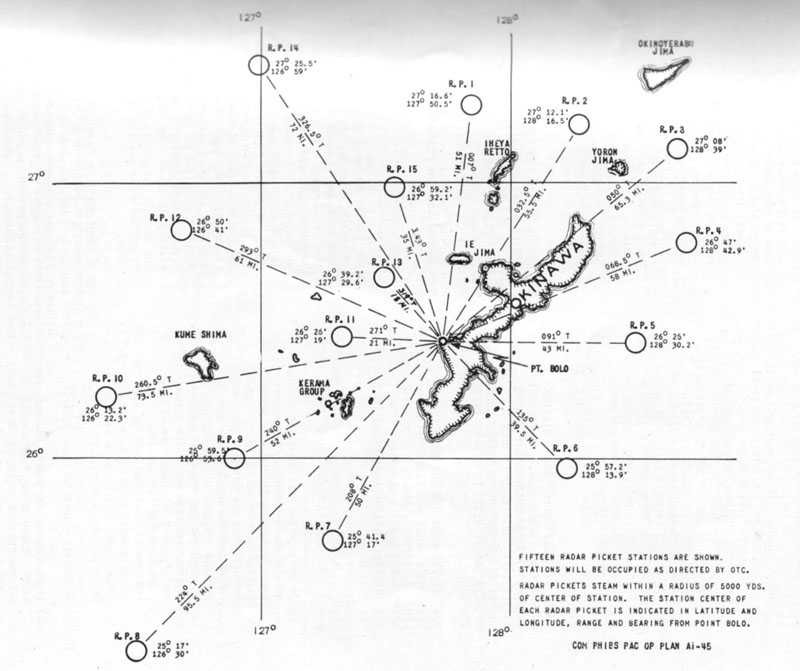
Use of Smaller Vessels as Radar Pickets.
If only one or two picket stations had to be filled, it might be possible to provide the ship acting as radar picket and fighter director with a substantial number of other ships for mutual support -- for example, a section or division of destroyers with perhaps a CL(AA). These ships could provide not only AA support but would also be in a position to act as advanced pickets to detect enemy surface craft -- particularly at night. However, the number of picket stations which might be required to be filled and the consequent unavailability of sufficient ships for this purpose would probably preclude adoption of this measure. Furthermore, there is the possibility that even with this additional support, substantial losses of destroyer types might be incurred.
THE USE OF SUBMARINES FOR RADAR PICKETS IS BEING CONSIDERED. AFTER DETECTING AND REPORTING THE APPROACH OF ENEMY PLANES, THE SUB COULD DIVE. LIMITED RANGE OF PRESENT SUBMARINE RADAR - PLUS REARRANGEMENTS INSIDE HULL - ARE PROBLEMS TO BE SOLVED BEFORE SUBMARINES CAN PERFORM THIS DUTY.
The alternative appears to be the use of smaller vessels as pickets -- the loss or damage of which can be more readily accepted. The smallest type sufficient to permit installation and operation of the necessary equipment and the berthing of personnel should be used. To provide an intense volume of fire against suicide planes, the greatest possible number of 40MM mounts controlled by latest types of directors should be installed. Since the ships would be operating out of range of other friendly ships (except close-in support craft), the use of 40MM ammunition without the self-destructive feature might be considered as means of increasing range.
Use of Small Craft as Picket Support: During the current operation many enemy planes were reported shot down by various kinds of small craft --particularly LCS and LCI types. The continued use of such craft in support of picket vessels and their close operation with the picket vessel in some type of AA disposition (particularly if the picket is also a relatively slow type) is recommended.
-
In some situations it might be feasible to establish facilities on outlying small islands. If not available or if so located that their retention would prove impracticable or too costly, perimeters on larger areas might be captured and held for this purpose. For example, in the current operation early establishment of radars and fighter direction communication facilities on western and northern islands of Kerama Retto, on Ie Shima and on the northern tip of Okinawa might have reduced the number of pickets required and hence the damage incurred.
EARLY INSTALLATION OF RADAR STATIONS ON OUTLYING ISLANDS COULD GIVE EARLY WARNING OF APPROACHING ENEMY PLANES. WHEN THIS IS POSSIBLE, IT WILL DECREASE THE REQUIREMENTS FOR FLOATING PICKETS AND DECREASE LOSSES OF THESE SHIPS.
JUST AS THE NAVY HAS FOR HUNDREDS OF YEARS MAINTAINED THE CLAIM "FIRST LINE OF DEFENSE", OUR NEW ELECTRONIC WEAPONS MAY RIGHTLY CLAIM THAT THEY ARE THE NAVY'S FIRST LINE OF DEFENSE.
It was reported that equipment was installed on the north of Okinawa and these facilities tied in with force fighter director on the Force Flagship. However, this was not done until after the Marines had moved up the island from the original landing beaches. It is submitted that the experience of the current operation may in the future justify early reconnaissance of positions favorable for installation of shore-based radar, followed by landings of sufficient troops to hold a perimeter large enough to enable the station to be installed and maintained.
--81-4--
THUS FAR THE SMALL CRAFT FOR PICKET SUPPORT HAVE DONE A MAGNIFICENT JOB. THE HIGH RATE OF FIRE OR THEIR 40 MM MOUNTS HAS ACCOUNTED FOR LARGE NUMBERS OF ENEMY PLANES ATTACKING IN FORCE.
Use of large Patrol Type Aircraft as Radar Pickets: This suggestion was made by the Commanding Officer of the USS Minneapolis in that ship's action report on Okinawa operation for period 21 March to 12 April 1945. It is probable that such planes might be used to serve one of the picket functions - that of early warning of approaching planes. But to carry out from an airplane the most important function of the pickets -- that of fighter direction - poses rather complex problems. Perhaps search radar and communication equipment suitable for fighter direction might be installed in large airplanes, and the problems raised by the rapid movement of the directing plane solved. A plane would certainly be less vulnerable than a surface picket and, in any case, its loss not so severe. However, at the present time the feasibility of fighter direction from specially equipped large aircraft seems a matter of doubt.
Use of Protective CAP for Pickets: During the current operation, after a picket reported a contact with enemy planes, control of all or part of these sections of CAP orbiting at point nearest contact was often shifted by force fighter director to that picket. The picket then vectored plane to intercept. Interceptions were often made many miles outside of picket stations with the result that planes which evaded friendly fighters were able to attack the picket without further air opposition. Later in the operation special protective CAPs were assigned to cover pickets in particularly exposed stations. Although results of activities of these special CAPs are not known to this command, it is believed that the assignment of at least four planes to each outlying picket - for use in interceptions close to pickets and for their own protection -- should aid materially against daylight attacks.
THE PICKET IS NOT AN ISOLATED UNIT BUT MUST BE A PART OF A SYSTEM. COMMAND MUST GIVE ADEQUATE AIR COVER WITH ADDED AIR SUPPORT WHEN NEEDED. SEE CIC CONTROL DOCTRINE IN USF 10.
Use of Fog Oil Smoke by Small Craft Picket Supports: The fog oil smoke screen provided in the Hagushi transport area at night was most effective. In the event small craft are detailed to give close support to radar pickets, it is suggested that for use in night attacks the small craft be equipped with suitable supply of fog oil and necessary generators. A formation employing the small craft making smoke to windward might then provide considerable protection for the radar picket vessel unless, of course, wind conditions were too unfavorable. Since high speed and maneuverability are not attributes of these craft anyway (assuming the picket is also a small or medium type), nothing would be lost by slowing to speeds most suitable for taking advantage of the smoke by maneuvering beneath it.
NARRATIVE
RADAR PICKETS IN ACTION
CO USS Hugh W. Hadley REPORTS:
1. The U.S.S. Hugh W. Hadley (DD774) was OTC of a force consisting of two destroyers, three LCSs and one LSM. In order to achieve maneuverability and concentrated gunfire, the following formation was ordered: the four small support ships in a diamond formation on a circle one thousand yards in diameter, speed ten knots, reversing course every half hour; the two destroyers in column distance fifteen hundred yards, speed fifteen knots. When attacks commenced, both destroyers increased speed to twenty-seven knots and maneuvered in vicinity of supports to concentrate gunfire.
2. On the morning of 11 May, at 0605, the Combat Air Patrol of twelve planes reported on station. At about 0740, bogies were reported to the northeast. At 0745, a large enemy float plane appeared through the mist and was taken under fire by both ships. Soon this plane headed away from the Evans and came directly for the Hadley which was about one mile and a half from the Evans. This plane was shot down by the Hadley at a range of 1200 yards.
3. At about 0755, numerous enemy planes were contacted by our instruments as coming towards the ship (and OKINAWA) from the north, distance about 55 miles. One division of CAP was ordered out to intercept. Shortly thereafter, several enemy formations were detected, and the entire CAP was ordered out to intercept. Our Fighter Director Officer in CIC has estimated that the total number of enemy planes was 156 coming in at different heights
--81-5--
in groups as follows: Raid ONE 36, Raid TWO 50, Raid THREE 20, Raid FOUR 20 to 30, Raid FIVE 20, Total 156 planes.
4. At about 0755 the entire Combat Air Patrol was ordered out in different formations to intercept and engage the horde of enemy planes closing us and shortly we received reports from them that they had destroyed twelve planes. Then they were so busy that they could not send us reports but we intercepted their communications to learn about forty to fifty planes were destroyed by them. CIC reported that there were no friendly planes within ten miles of this ship.
5. From this time on the Hadley and the Evans were attacked continuously by numerous enemy aircraft coming at us in groups of four to six planes on each ship. During the early period, enemy aircraft were sighted trying to pass our formation headed for OKINAWA. These were flying extremely low on both bows and seemingly ignoring us. The Hadleyshot down four of these.
6. The tempo of the engagement and the maneuver of the two destroyers at high speed was such as to cause theHadley and the Evans to be separated by distances as much as two and three miles. This resulted in individual action by both ships. Three times the Hadley suggested to the Evans that they close for mutual support and efforts were made to achieve this but each time the attacks prevented the ships from closing each other. The Hadley closed the four small support ships several times during the engagement.
7. From 0830 to 0900 the Hadley was attacked by groups of planes coming in on both bows. Twelve enemy planes were shot down by the Hadley's guns during this period, at times firing all guns in-various directions. The Evans, which at this time was at a distance of about three miles to the northward, was seen fighting off a number of planes by herself, several of which were seen to be destroyed. At 0900 the Evans was hit and put out of action. At one time toward the close of the battle when friendly planes were closing to assist us, the four support ships were prevented from shooting down two friendlies whom they had taken under fire. One plane was seen to splash inside their formation due to their own gunfire. However, I am not able to give an accurate account of their action. They were very helpful in picking up my crew who were in the water, in coming alongside and removing wounded and in helping us to pump.
8. From this time on, the Hadley received the bulk of the attacks and action became furious with all guns firing at planes on all sides of the ship. CIC reported that the SUGAR GEORGE radar scope was filled with enemy planes. The Commanding Officer saw that the situation was becoming too much for one ship to handle and he ordered the Combat Air Patrol to close the formation and assist us. With outstanding courage, our planes fearlessly closed the ships and attacked enemy planes. They achieved great results and when the Hadley was finally helpless in the water, our crew was sparked with renewed courage by the sight of our airmen driving off the remaining enemy aircraft.
9. For 20 minutes the Hadley fought off the enemy singlehanded, being separated from the Evans, which was out of action, by three miles and from the four small support ships by two miles. Finally, at 0920, ten enemy planes which had surrounded the Hadley, four on the starboard bow under fire by the main battery and machine guns, four on the port bow under fire by the forward machine guns, and two astern under fire by the after machine guns, attacked the ship simultaneously. All ten planes were destroyed in a remarkable fight and each plane was definitely accounted for. As a result of this attack, the Hadley was (1) hit by a bomb aft (2) by a BAKA bomb seen to be released from a low-flying BETTY (3) was struck by a suicide plane aft (4) hit by a suicide plane in rigging.
10. The ship was badly holed and immediately both engine rooms and one fireroom were flooded and the ship settled down and listed rapidly. All five-inch guns were out of action, a fire was raging aft of number two stack, ammunition was exploding, and the entire ship was engulfed in a thick black smoke which forced the crew to seek safety, some by jumping over the side, others by crowding forward and awaiting orders. The ship was helpless to defend herself and at this time the situation appeared hopeless. The Commanding Officer received reports from the Chief Engineer and the Damage Control Officer which indicated that the main spaces were flooded and that the ship was rapidly developing into a condition which would capsize her. The exploding ammunition and the raging fire appeared to be extremely dangerous. The engineers were securing the forward boilers to prevent them from blowing up. The order "Prepare to abandon Ship" was given and life rafts and floats were put over the side. A party of about fifty men and officers was being organized to make a last fight to save the ship and the remainder of the crew and the wounded were put over into the water.
11. From this point on, a truly amazing, courageous and efficient group of men and officers with utter disregard for their own personal safety
--81-6--
approached the explosions and the fire with hoses and for fifteen minutes kept up this work. The torpedoes were jettisoned, weights removed from the starboard side, and finally the fire was extinguished and the list and flooding controlled and the ship was saved. Although the ship was still in an extremely dangerous condition, one fireroom bulkhead held and she was finally towed safely to the IE SHIMA anchorage.
A STRIKING EXAMPLE OF SUCCESS BY PERSONNEL WHOSE CONTROLLING THOUGHT WAS, "DON'T GIVE UP THE SHIP."
12. The total number of enemy planes destroyed by the Hadley in this period of one hour and thirty-five minutes of continual firing was twenty-three. This number includes twenty shot down to the water and three suicide hits.
Our mission was accomplished. The transports at the OKINAWA anchorage were saved from an attack by one hundred and fifty-six enemy planes by the action of our ships. We bore the brunt of the enemy strength and absorbed what they had to throw at us. It was a proud day for destroyer men.
THE SHIP'S MISSION WAS GALLANTLY COMPLETED BUT INADEQUATE AIR SUPPORT WAS EVIDENCED. PROPER AIR SUPPORT WAS NECESSARY AND URGENT. WAS THE SYSTEM IN USE TOO INFLEXIBLE? OUR FIGHTERS WERE OUTNUMBERED OVER 5 TO 1. A PICKET SHOULD BE PART OF A SYSTEM AND NOT JUST AN UNCOORDINATED UNIT.
Officer in Charge, Fighter Direction Team aboard USS Hugh W. Hadley reports: (Refer to Chart, page 8.)
1. This action lasted from about 0750 until about 0915 at which time all enemy planes were shot down and both DDs of R.P. No. 15 were out of action.
2. Action began when high CAP intercepted and shot down one Frances by Viceroy 11. At the same time two float type planes were sighted by ship's lookout: and low CAP. One Paul shot down by ship's five-inch battery. No further reports on the other, presumably shot down in the melee. Both pontoons of this plane exploded when it hit the water. Presumably it was specially prepared as a suicide plane, with pontoons filled with explosive, and equipped with contact detonators. This plane splashed 300 yards off the starboard beam while making a very low run on the ship.
3. About 0800 this ship picked up a large bogey, 345 degrees, 100 miles from BOLO. Viceroy 11 and 13 at Angels 15 over Pt. Uncle were vectored out for an intercept as a single flight. Raid split at 30 miles from ship and CAP was split to intercept each half. Viceroy 13 tallyhoed six planes, Viceroy 11 tallyhoed 30 planes. Viceroy 13 quickly disposed of his six and went to the aid of Viceroy 11. Few, if any, of these planes escaped them. This is designated as Raid 1 on attached diagram. Raid 2, estimated 50 planes, flew directly over Pt. Uncle where Panamint's CAP of 8 planes engaged them. HEINE 1 was asked to send help and his planes orbiting Pt. Tare were directed to proceed to Pt. Uncle and vicinity and join the fray. No vectors were necessary. Raid 3, also appeared at this time and was on a course to pass to westward. Information was passed to Lowry in R.P. station 16 and he was asked to intercept it, which he did. His 4-plane CAP tallyhoed 20 enemy planes and effectively disposed of them. At the height of the combat, Raids 4 and 5 appeared. Raid 5 flew directly into the melee to the northeast of us and was engaged. It was impossible to vector any planes to meet it as none were left unengaged. At this time Viceroy 11-1 reported he was out of ammunition but he was staying on to do what he could. He shortly reported forcing one Betty into the water and set the pace for all planes to standby. Several more planes were also forced down in this manner by pilots unknown. Raid 4 came in at the same time, passed by the melee intact and when 10 miles north of the ships, fanned out, circled the formation and attacked from all sides. This raid was opposed by RUBY 15 (two-plane R.P. patrol) only. Some enemy planes were shot down and a coordinated attack was partly broken up, but the majority of these planes got through to the ships and were mostly destroyed by AA gunfire. Both RUBY 15 planes began picking off stragglers at the beginning of the action, then opposed Raid 4, estimated 20 to 30. When enemy planes closed, these two planes came in with them. One very outstanding feat by one of these two planes (believed to be RUBY 15-1, but not verified) was that though out of ammunition, he twice forced a suicide plane out of his dive on the ship and the third time forced him into such a poor position that the plane crashed through the rigging but missed the ship, going into the water close aboard. This was done while
--81-7--
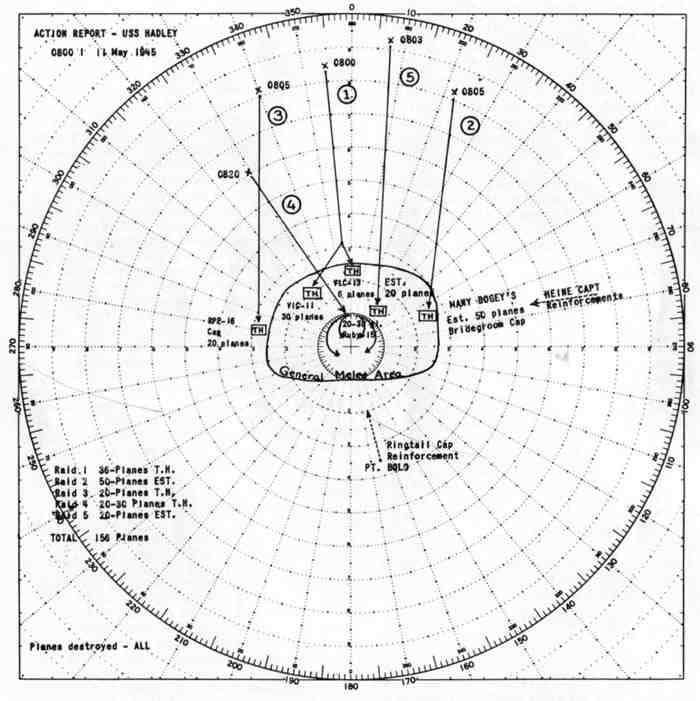
--81-8--
all guns on the ship were firing at the enemy plane. The highest award for flying skill and cool courage not too much for this pilot. His wingman also stayed at masthead height in the flak and assisted in driving planes away from the ship. At the time the ship was hit below the waterline, power failed, our VHF radios were already inoperative from antennas carried away by a diving plane, and all communications were lost except on SCR 610 battery operated emergency set on 34.8 M.C. However, only three bogeys were left airborne and they were all being harassed by the original CAP, now out of ammunition and low on fuel. It is believed these last planes were splashed by reinforcements coming from BOLOunder control of RINGTAIL BASE. None escaped to return to Japan.
4. First plane shot down was a Frances over Pt. Uncle by Viceroy 11, quite possibly the coordinator as he was 20 miles ahead of the main bodies of planes and alone. There seemed to be an assortment of all types of planes, including many torpedo planes which were all splashed before they launched torpedoes. Air traffic on the fighter net was too heavy to keep track of splashes. Before fighting become general, the CAP had splashed 15 planes, ship's gunfire had splashed 11 for Hadley, 4 for one small craft, others unreported. After the big melee began no further attempt was made because all nets were already overcrowded with tactical traffic alone. No raids attacked the ships unopposed, and except for raid 4, stragglers from the melee were the only ones who were able to close the ships.
5. From the beginning to the end, the Hadley was under attack by planes attempting suicide dives on it. The ship was maneuvered so that maximum battery fire was always presented. At one time this ship had seven different air targets under fire simultaneously. The Commanding Officer of this ship deserves special commendation for an exceptional job of defending his ship against terrible odds. Enemy planes were taken under fire many times without harm to friendly planes attacking the same target.
6. Communications -- Communications on IFD net were excellent. Gunfire shocks knocked loose patch panel connections repeatedly, but a man in radio control stood by and kept them operational. TBL transmitter was used and it stayed functional even after terrific shock which knocked out most radios, until power failed. AN/ARC1 - Receiver failed after a few minutes of firing 5-inch batteries. SCR 624 - Stayed functional during battle. SCR 610 - Functional and used to call support ships for assistance and to pick up survivors after all other communications were a casualty. (Battery operated). TCS - Both failed from shock of explosion in engineering spaces. TDQ transmitter, RCK receiver - Perfect performance until diving plane tore down antennas. Net discipline very good on IFD. Net discipline by all planes and most stations on fighter nets was very good. RINGTAIL BASE had a tendency to talk too much and crowded more important tactical traffic off the air.
7. Radar performance -- Excellent performance was given by both SC and SG radars. Fire control was not available for other purposes than gunnery.
8. Fighter Direction Team -- The CASCU radar-men manned the air department of CIC and gave the best performance I have ever witnessed. All raids were picked up at maximum range and perfect track; estimates of composition and altitude were put on the board by this crew without prompting.
9. Enemy tactics - Each raid seemed to split up into general melee as soon as attacked by our planes. Most Jap planes stayed in plane-to-plane combat, but many from each raid, and especially Raids 2 and 4, bypassed the dogfighting and came on in to attack the ships. One common approach was for two planes to come in close as a formation, then, when within machine gun range, to split and each attempt a dive at the ship. Nearly all attacks on ships were potential suicide attacks, but the same plane would give way to avoid collision with one of our planes which was attacking it without ammunition. Little, if any, window was observed although unused window was recovered from wreckage aboard theHadley. Raid 4 made a good coordinated attack. They came in and when 10 miles from the ship fanned out into several groups which circled the formation and then pressed home simultaneous attacks from all directions. They were not diverted by our planes but pressed home attacks on shipping until shot down by AA or forced into the water by CAP planes which by now were nearly all out of ammunition.
THESE TACTICS MAKE IT OBVIOUS THAT THE BEST ACCEPTED PRINCIPLES OF FIGHTER DIRECTION MUST BE FOLLOWED. COULD THE SIMULTANEOUS ATTACKS FROM ALL DIRECTIONS HAVE BEEN PREVENTED BY BREAKING UP THE INITIAL CIRCLING OF ENEMY PLANES FOR ADVANTAGEOUS POSITIONS? WERE ALL RAIDS OPPOSED BY ADEQUATE FIGHTERS? WERE THE FIGHTERS KEPT BETWEEN THE RAID AND BASE? THE PICKETS WERE HARASSED AND FINALLY HIT BY UNMOLESTED ENEMY PLANES.
--81-9--
CO USS Evans reports:
PRELIMINARY
1. The Evans and Hadley departed from the HAGUSHI anchorage on the afternoon of 10 May 1945, under orders of CTG 51.5, and arrived on Radar Picket Station #15 about 1500. Other ships in support on that station were LSM 193, LCS 82, LCS 83 and LCS 84. The latter four ships were disposed in a diamond formation 1000 yards on a side, their course reversed about every half hour by signal, speed maintained at 10 knots. Hadley and Evans were in column in that order, speed 15 knots, distance 1500 yards, circling the support formation at a distance of about one mile. Hadley was Fighter Director Ship and controlled a small Combat Air Patrol. Evans was Fire Support Ship. At 1934 that evening a Jap "Kate" was shot down by this ship.
2. From 0151 until 0340, 11 May 1945, remained at General Quarters as there were enemy aircraft in immediate vicinity, probably on reconnaissance missions. Early in the morning of the 11th, a general warning was received from Commander Fifth Fleet to expect heavy air raids during the day.
3. Enemy aircraft were again in the area from 0640 to 0654, after which we were in the clear until commencement of the action which this report covers.
CHRONOLOGICAL ACCOUNT OF ACTION
4. During this action the sea was calm, wind 12 knots from 170° T., barometer 29.90" starting to rise, air temperature dry bulb 74° F., wet bulb 71° F., main injection temperature 78° f. There were low scattered stratocumulus clouds at about 5000 feet, and a higher layer of altostratus clouds, total of sky covered about seven-tenths. Visibility moderate to good, from 5 to 10 miles. The calm sea and light wind were very favorable factors in rescuing men blown overboard and in saving the ship itself.
5. At 0745 there were radar indications of a bogie coming in from the north, and 0751 a seaplane was sighted about 10 miles on the port quarter (own formation base course 055° T). Although from the side view it appeared possible that the seaplane was friendly, the ship went to General Quarters, set Condition Able and increased speed to 27 knots. By 0753 the plane had been identified as a twin-float "Jake" and the main battery opened fire, followed by 40MM and 20MM guns as range closed, target angle zero; the ship was maneuvered to bring as many guns as possible to bear. At 0757 the plane was shot down 1000 yards on the starboard quarter, a tremendous explosion out of all proportion to its size resulting when it hit the water.
6. During the following account it should be borne in mind that it is impossible to give true bearings in most cases due to the fast pace of the action, and because the ship was being maneuvered at maximum available speeds of from 28 to over 30 knots, with the purpose of bringing as many guns as possible to bear, and at the last moment to take violent evasive action, reversing the direction of a well-outlined turn if possible. Whenever opportunity offered, the Hadley was closed for mutual fire support, but the action was too furious to be entirely successful in this.
7. There were no further contacts until 0830, when 3 low-flying planes were picked up by SG radar bearing 350° T. (off port quarter) at 10 miles. Commenced tracking immediately and opened fire with main battery at 0831. Shot down leading plane, a "Kate" at 6000 yards. The second "Kate", coming in 1500 yards directly behind the first, received direct 5" hit and disintegrated at 4000 yards. The third "Kate", which had changed course to its left and was closing on a bearing of 030° T., was splashed in flames as a result of 40MM fire 500 yards off Evans port beam. All three of these planes were shot down within two minutes. A severe enemy air attack was developing and planes closing from all directions.
8. At 0835 with Evans closing Hadley from 3500 yards on his starboard quarter, Evans and Hadley both opened fire with 5" on an enemy aircraft (type undetermined) closing on Hadley's starboard beam and ahead of Evans. Hits were observed and the plane was splashed dead ahead of Evans and about 3000 yards on beam of Hadley (an assist withHadley). At 0839 a "Zeke" approached from high on starboard quarter in steep dive, taken under fire by Evans 5" battery at 7000 yards, by 40MM at 3500 yards, and shot down in flames at 2500 yards. At 0841 a "Zeke" approached from high on starboard quarter in steep suicide dive and was shot down by 40MM and 20MM fire, hitting the water 800 yards on starboard beam. At 0845 a "Tony" approached on Evans port bow toward Hadley (then on Evans port bow 3000 yards) in a shallow dive at high speed and was taken under fire by main battery at 5000 yards. Hits were observed and plane splashed close aboard Hadley on her port quarter (an assist with Hadley).
9. Less than two minutes later a "Tony" approached from high and deep on port quarter in a very steep dive, was taken under fire by 40MM and 20MM and set on fire. It dropped a bomb close aboard on starboard bow, and was shot down by 5" battery at 1500 yards off the starboard bow going
--81-10--
away. At 0849 an "Oscar" approached from port quarter in shallow dive at high speed. Taken under fire by 5" battery at 6000 yards and 40MM battery at 4000 yards, it crashed in flames 1000 yards off port quarter of Evans. Less than a minute later, without ceasing fire, and with 5" guns in automatic, the director was slowed forward from port quarter to port beam and approaching "Jill" was taken under fire at 10,000 yards. This "Jill" was shot down at 7,000 yards.
10. At 0851 a "Kate" was observed closing Evans rapidly on a bearing of 330° relative, and taken under fire at 5000 yards by main battery. The enemy plane, although hit and burning severely, continued to close until at about 200 yards nearly broad on port bow it launched a torpedo. Hard left rudder was applied, with the ship making about 10 knots, and fortunately the torpedo crossed just ahead of bow less than 25 yards. The "Kate", already on fire, was shot down going away 2000 yards off starboard bow by 5" fire.
11. At 0854 a "Tony" approaching from Evans port bow was taken under fire by Hadley and Evans main batteries at 7000 yards, with hits observed from both ships. Plane was shot down an equal distance from Hadley and Evans at 3500 yards (an assist with Hadley). 0856 observed "Val" coming in from high and deep on port quarter. It was taken under fire by main battery at 6000 yards, by machine guns at 4000 yards. Numerous hits were scored and the enemy plane set on fire. Although he attempted to suicide, it appeared the plane was out of control as it crossed over ship and crashed in water 2000 yards off starboard bow.
12. 0901 "Oscar" approached from deep on port quarter in shallow high speed dive. Taken under fire by main battery at 6000 yards, hit and set on fire at 4000 yards. This "Oscar" dropped a bomb which landed 400 yards off Evans port quarter. It then made an unsuccessful suicide attempt, and finally crashed 1500 yards on port bow.
13. By 0902 two more boilers had been cut in and Evans was making speeds in excess of 30 knots as we maneuvered radically to avoid suicide planes. At the same time the main battery was downing the "Oscar", a low-flying "Jill" approached from port beam directly toward Evans, taken under fire by the 40MM at 5000 yards. Machine guns shot off port wing and the "Jill" crashed barely 500 yards from ship on port beam. At 0904 a "Tony" coming in on port quarter at an estimated altitude of 2500 feet was shot down by Evans' first salvo at 9000 yards.
14. At 0907 Evans received first hit by suicide plane when a "Judy", approaching from the port bow, although hit and damaged by Evans gunfire, struck at water line port side frame 16. Hit resulted in hole 3' by 4', which flooded lower sound room and forward crew's living compartment. No power was lost, although telephone communications with CIC went out temporarily due to breakage of telephone junction box caused by shock.
15. The next enemy plane encountered was a "Tony" which at 0909 at about 2000 feet altitude and in a shallow dive, approaching on port beam, was taken under fire by Evans main battery at 8000 yards and was destroyed as direct 5" hit was scored at 3500 yards. Less than two minutes later an enemy aircraft (type undetermined) approached from port beam in high speed glide dive from approximately 3000 ft. Taken under fire by main battery and machine guns which set him on fire, he succeeded in suiciding aboard in vicinity of frame 122 below waterline. This plane was carrying a bomb or torpedo which, from divers' reports, exploded just outside the after fireroom hull. The Jap pilot's body was found on the fantail. The after fireroom and after engineroom flooded instantaneously as a large portion of the bulkhead between them was blown out. Steering control was lost temporarily at this time but quickly shifted to trick wheel; speed reduced to approximately 18 knots.
16. At 0913 enemy "Oscar" in steep dive from high altitude out of sun, on port quarter, was taken under fire by 5" battery and after 40MM. Although hit by gunfire, this plane was successful in suiciding Evans. This suicide "Oscar" was carrying a bomb which was released just before plane crashed through superstructure deck over galley. The bomb penetrated main deck and exploded in the forward fireroom, causing both boilers to explode. At the same time, a second enemy suicide, also an "Oscar", approached from the starboard bow, under fire and being hit by machine gun batteries, struck the after starboard boat davit, crashed to the main deck just forward and outboard of the other "Oscar", and resulted in gasoline fires on main deck, bridge and director deck. One of the Jap pilots was found in the galley, the other on the main deck. All light, power, steam, water pressure and most communications were lost andEvans was dead in the water. The diesel generator cut in, but was secured as fuel oil and water covered part of the switchboard in that compartment.
17. At 0925 the final attack of the action occurred when an unidentified enemy aircraft was sighted
--81-11--
dead ahead at 4000 yards, diving on the ship, with two F4Us of the Combat Air Patrol in hot pursuit. The enemy was taken under fire by 40MM machine guns and hits by #2 40MM at 2500 yards were observed on port wing. These hits, with perhaps others by the Combat Air Patrol, disturbed the plane's flight attitude sufficiently to cause it to miss the bridge. The plane passed down the port side and crashed astern, close aboard.
18. As there was no pressure on fire main, it was necessary to form bucket brigades. Using 40MM cans, buckets, CO2extinguishers and gasoline handy billy pumps, progress was being made in extinguishing the fires when the USS LCS 84 came alongside to starboard at 0929. The assistance rendered by the LCS 84 was invaluable. By 0950 all fires were extinguished and, with salvage gear furnished by LCS 84 plus the handy billies Evans had in operation, pumping was started in the forward engine room and compartment A-302-C. At this time the ship's draft was 22 feet forward and 17 feet 6 inches aft. Twenty-seven of the wounded were treated aboard Evans and transferred to the LCS 84 for further transfer to USS Ringness (APD 100). The latter also took off 120 of our personnel not required for salvage work.
19. Although there had been a maximum list of 3° to starboard, topside weights were a source of concern. The port anchor had been jettisoned earlier when we were taking water from the hole in the port bow. All depth charges, smoke screen generators, and a considerable amount of topside ammunition were jettisoned. Eight torpedoes were fired, the remaining two torpedoes and tubes having been damaged by suicide plane crash.
20. At 1045 the USS LCS 82 completed picking up personnel blown overboard, came alongside to port and immediately commenced pumping flooded compartments. All bulkheads in compartments adjacent to those flooded were shored byEvans repair parties.
21. LCS 84 shifted to the port side and at 1108 USS Harry E. Hubbard (DD748) came alongside to starboard. This ship rendered great assistance by lending pumps and salvage equipment, in addition to furnishing impulse charges which enabled us to fire 5 of the 8 torpedoes which were jettisoned. At 1110 LCS 82, making no headway in pumping after engineering spaces, shifted suctions to forward engineering spaces.
22. At 1300 when Hubbard cleared the side, the USS Arikara (ATF98) came alongside, commenced pumping forward engineering spaces, and furnished additional pump for the forward living compartment. From this moment on, definite progress was made. At 1350 the Arikara cast off from alongside and commenced towing from ahead for the anchorage at Ie Shima. The draft had been reduced forward by two feet and aft by one foot. At 1450 USS Cree (ATF84) came alongside to starboard and assisted in towing and salvage. From 1630 to 1900 Evans pumped fuel overboard. With Creealongside to starboard, LCS 82 and LCS 84 to port, and the Arikara towing, the Evans made the remainder of the trip to Ie Shima without incident. A long day was brought to a close when the Cree dropped her anchor at 1915.
RADAR PICKETS AND THEIR ASSOCIATES ARE DESERVING OF THE HIGHEST PRAISE FOR THEIR OUTSTANDING PERFORMANCE OF DUTY.
Gunnery Officer, USS Evans, comments:
1. During the attack I observed 30 to 35 enemy aircraft shot down and crash into the sea. Under such a rapidly developing and sustained attack, detailed data covering the action in places is obscure, but the planes accounted for by this vessel (15 unassisted, 3 assists with the Hadley, one assist with CAP, plus four which though damaged were successful in suiciding into the Evans) have been verified by the ship's officers and other personnel.
2. Japanese suicide tactics remained more or less unchanged as reported by other ships who have undergone suicide attacks, with one notable exception; that is, not until the closing minutes of the action, when practically all of their aircraft had been expended, was there any indication of a coordinated attack. The final attack, however, was well coordinated and in the moments just prior to the Evans being hit, this vessel had 3 aircraft under fire simultaneously.
3. The first suicider, which hit the port bow (frame 16) at the water line, did little damage; the entire gun battery remained in full operation. The second plane, whose bomb exploded in the after fireroom (frame 122), severed all power and fire control cables to the after guns (5" Gun 3-4-5, 40MM 3-4-5). Power to these guns was never regained but they continued to fire in manual. The third and fourth suiciders, which hit almost simultaneously in the forward fireroom, destroyed all power to the forward guns (5" Gun 1-2, 40MM 1-2, Main Battery Director, Computer and stable Element).
--81-12--
All guns were operative in manual. The last plane to attack was hit in the port wing by #2 40MM (firing in manual) and passed down the port side, crashing approximately 250 yards astern.
4. After all power had been lost, the Gunnery Officer ordered the Main Battery Director abandoned and its crew to assist in salvage work as he, himself, proceeded to assume duties as Executive officer, taking charge of Damage Control and Salvage Operations. This was done since the Executive Officer had been critically wounded. Also at this time the Assistant Gunnery Officer assumed duties as Gunnery Officer, taking over control duties of the 5" guns which were still operative in manual power local control as well as machine gun control. These batteries were kept manned and alert until arrival at Ie Shima anchorage.
5. During this attack the Evans fired approximately 800 rounds of 5"/38, 3400 rounds 40MM, and 5500 rounds of 20MM ammunition. In addition, all depth charges, smoke screen tanks, and eight torpedoes were jettisoned to improve stability as the ship was rapidly settling.
6. The performance of the ordnance equipment was magnificent, with not one casualty in the 5" battery until the ship was struck by the second suicider.
7. The conduct of personnel was outstanding. Despite the fact that 3 aircraft were shot down within 800 yards of the ship and that there were near misses by a 500-pound bomb and a torpedo dropped within 200 yards of the ship, all hands remained at their stations and continued to fire their mounts until cease firing was ordered.
CO USS Purdy reports:
12 April 1945:
1. Patrolling Radar Picket Station #1 as before. One division of combat air patrol was orbiting overhead and a second division was returning from the north. The visibility at this time and throughout the entire subsequent action was excellent, ceiling unlimited, the wind from direction of 020° (T), force 10 knots. Condition II (watch and watch) had been set at 1150 in order to feed the crew; i.e., one gun in each of three 5" twin mounts, two 40mm quads (Mk 63 Fire Control System), two 40mm twins (Mk 51 directors) were manned; two boilers cut in with boiler power for 27 knots available and with remaining 2 boilers fully ready and standing by to be cut in on main system line; Condition Able modified (partial ventilation and flushing cut in and some living compartments made accessible).
2. At 1310 a bogey was contacted by both ships, simultaneously, bearing 034° (T) range 74 miles. This raid dropped window. The Purdy manned general quarters stations at 1313. This first bogey (raid 1) passed to the eastward on a course of 170° (T) at a range of 65 miles. The combat air patrol returning from the north was vectored to intercept this raid; however, the raid passed ahead of CAP. Raid 2 was contacted shortly after initial contact of Raid 1. Raid 2 passed to the west at about 80 miles bearing 230° (T). Combat Air Patrol, orbiting ship, was vectored to intercept this raid.
3. Raids 3 and 4 were then contacted to the northward. Raid 3 split into raids 5, 6, 7, and 8 at 50 miles bearing 000° (T). Raid 4 bearing 345° (T), 45 miles was on a course of 230° (T). This raid is believed to have consisted of 10 Zekes which attacked the USS M.L. Abele (DD733). Raid 5 (possibly a split of Raid 1) passed clear to the eastward on a southerly course. Raid 6 at 015° (T), 42 miles, course 140° (T) faded and no further contact was made. This raid possibly attacked Radar Picket Station No. 2. Raids 7 and 8 were contacted simultaneously on bearing 005° (T), 35 and 45 miles respectively. At 1330 the Mk. 12 F. C. radar (Mk 37 gun Director) was coached on raid 7 by Combat and picked up air target in full radar control at 20 miles bearing 034° (T). Raids 7 and 8 appeared to be making radical course changes from point of initial contact until the Mk 28 pick up.
4. Run No. 1:
(a) At 1337 Purdy (600 yards astern Cassin Young) opened fire on single Jap plane approaching column from starboard bow at 10,000 yards, full automatic, partial radar control; fire was checked twice to permit visual observation (smoke and blast interference). Cassin Young opened fire at same plane at range of about 6,000 yards. Plane made a high angle dive bombing attack on Cassin Young from starboard bow, dropping a bomb close aboard her to starboard. Plane pulled out across bow of Cassin Young, circled to port, and made a low suicide run on her port quarter. Purdy resumed fire, having checked fire when plane dropped bomb, and continued firing until plane was about to cross Cassin Young. Plane crashed close aboard on Cassin Young's starboard quarter. Purdy's 40mm mounts 41 and 43 commenced firing at this plane at 5,000 yards; twin mount 41 being controlled by main battery director and Quad Mount 43 by the Mk 63 Fire Control System. Mount 43 made radar pick-up at 8,000 yards; 20mm battery commenced firing at 2,000 yards. This plane is tentatively identified as a Zeke but all planes were variously identified by ships and aircraft
--81-13--
present as Zekes, Kates, Oscars, and Vals. It appears well established, however, that Vals predominated in number.
(b) At 1342 Raid 8, bearing 270° (T), was sighted visually on starboard quarter. Friendly planes were contacted on SC radar, 10 miles to the southeast. Commenced firing (few rounds of 5") on Raid 8, which consisted of 5 Vals, at a range of 8,000 yards opening. These planes closed support craft (LCS) and appeared to drop a bomb, or one plane made suicide attack, which was a near miss. Friendly fighters closed the above Vals and splashed two.
5. Run No. 2:
Almost immediately a Val made a suicide run on the port bow of the Cassin Young. This Val was under fire from both ships and was definitely hit. The plane struck the port yardarm and SC radar antenna of Cassin Young, possibly hitting the starboard side of the main deck, and slid overboard. The Cassin Young began smoking badly with forward fireroom out of commission.
6. Run No. 3:
(a)At 1345, during this suicide attack, a plane was spotted visually (range about 12,000 yards) on starboard quarter, skimming the water and approaching Purdy from out of the sun. After suicide plane attacking Cassin Young was splashed, the Purdy 5" battery checked fire and picked up this plane (Val) on starboard quarter. The 5" battery commenced firing in full automatic at 8,000 yards. Quad 40mm Mount 43 "gated" plane at 9,000 yards, commenced firing at 5,000 yards. Plane winged over and splashed at about 2,500 yards. 40mm fire (Mk 63 Fire Control System) was very effective and possibly accounted for this Val.
(b) At 1407 the Cassin Young changed course to the south, speed 25 knots, followed closely by the Purdy in support role. CDD 126 directed Purdy to return to Radar Picket Station 1. Purdy changed course northward and Cassin Youngretired to southward toward Kerama Retto. At this time Combat reported "about 50 bogies to the north."
7. Run No. 4:
At 1442 one plane believed to be a Val attacked from starboard. Friendly fighters closed the many Jap planes in vicinity and splashed several bandits at this time. Attacking plane made approach from 050° (T) (starboard side) in a steep glide. Opened fire at 6,000 yards, friendly fighters closed and Purdy checked fire. Fighters were hitting Val which began to smoke but continued in straight dive. Resumed fire at 1,500 yards with 5", 40mm, and 20mm. Val swerved to the right and splashed close to port bow. Our fighters definitely hit Val; however, it is believed plane would have struck the ship if it had not been hit heavily by ship's fire. This Val strafed ship during his approach.
8. Run No. 5:
During above attack at 1450 made bogey radar contact on a few planes at 10 miles. At 1452 made visual contact at about 8 miles, and fired several bursts at planes to attract CAP which was vectored to intercept raid. During this firing it is possible that one plane was splashed by gunfire as several of crew observed a plane "splash" from the direction ofPurdy's gunfire. This, however, is not fully confirmed. There were no friendly fighters in proximity of this Jap plane at the time Purdy fired 5" battery. CAP closed "bandits" and dog fights ensued - more Jap planes were splashed by CAP.
9. Run No. 6:
At 1458 one plane broke away and made approach from sharp on port bow. All guns which could bear opened fire. Plane passed across bow from port to starboard, banked steeply, crossed 5" Twin Mount #3 very low, and splashed close aboard on port quarter.
10. Run No. 7:
(a) At 1500 the final attack came from a Val which crossed from port bow to starboard bow. It was attacked by 3 fighters and received many hits. Val broke away and dived for ship from starboard bow, smoking badly. Approach made from 20° position angle in a shallow dive on starboard bow. Purdy commenced fire with 5" at range of about 9,000 yards then checked fire when it appeared our fighters would splash the Val. Fighters made numerous passes; however, Val continued approach. Resumed fire at 6,000 yards with all batteries. Plane apparently lost control, hit water about 20 feet from starboard side of ship, and ricocheted into side of ship at frame 63. The AP bomb or projectile carried by the plane pierced side of ship about 8 feet above water line and exploded internally. Only a few parts of the plane were recovered on board. A total of 10 men were blown overboard; all were recovered by LCS 114, and later transferred by LCS 114 to APA 21 (Crescent City).
--81-14--
(b) Of special interest on this final attack is the fact that 5" Twin Mounts Number 1 and 3 had almost exhausted their mark 40 fuzed projectiles just prior to this final run. These two mounts were in the process of obtaining replacements from Mount #2 (firing Mark 18 fuzed projectiles by doctrine). During last part of the plane's approach, therefore, all three 5" Twin Mounts were firing Mark 18 fuzed projectiles. It is believed that the use of special fuzes would have made the difference between being hit and destroying the plane during its approach.
11. After being hit, Purdy lost steering control, practically all internal and external communications, and partial engine power (forward fireroom inoperative), 5" Twin Mounts #1 and 3 in operation in local control only (Mt. #2 inoperative, all 40mm mounts operative in automatic with alternate supply. Ten torpedoes were jettisoned, primarily in order to reduce danger of war head explosions in the event of additional expected attacks.
12. One shipboard enlisted observer who kept a tally of the "splashes" made by friendly fighters, by surface ships including LCS type, and by suicide hits, stated that he counted a total of 22 splashes during the 86 minute air action. It is believed that at least 20 and probably about 25-30 Japanese planes were destroyed in the above action. Duplication of claims for plane destruction by friendly units engaged is inevitable and the grand total based on those claims, therefore, may be well over the above estimate.
Note: DRT track in CIC was made unreadable by combination of blast smoke and steam which followed the bomb hit.
AN OUTSTANDING PERFORMANCE OF DUTY AND AN EXCELLENT REPORT FOR DETAILED INFORMATION.
CO USS Stanly reports:
1. During the morning of 12 April we continued routine patrolling of radar picket station #2. All hands were at general quarters because of various enemy planes in the area and the expected air attack from the Japanese mainland. At 1351 we proceeded toward radar picket station #1, pursuant to verbal orders of CTG-51.10 to assist the USS Cassin Youngwho was then under heavy air attack. Enroute to station #1 we fired with 5" battery at and dispersed a group of five "VALS" flying very high. They continued on a course southwest toward OKINAWA JIMA.
2. At 1426 an enemy plane, identified as a "VAL", approached high on our port quarter. It dived in what appeared to be a deliberate suicide attempt. Near misses by 5" battery and some hits from automatic weapons caused it to pass over us amidships from port to starboard. It succeeded in pulling out of its dive but was observed to crash into the water off our starboard quarter while under fire of our starboard battery and the USS Lang's guns. At this time the concussion of the ship's gunfire broke a condenser in the main gyro, thus rendering it inoperative.
3. At 1449, diving out of a melee on our starboard beam, an unidentified plane outran our Combat Air Patrol and was taken under fire by 5" battery and automatic weapons as it approached on a collision course. The plane, although hit by automatic fire, crashed into our starboard bow, frame 23, about five feet above the water line, parts of it passing through the ship and continuing through the port side. A large explosion off the port bow at this time seemed to indicate that a bomb exploded there after passing through the ship. The plane was approximately 20 feet long, had a 15 foot wing span and no engine or propeller was observed. Remains of a pilot were found in compartment A-302-L with the wreckage. Our speed at this time was 30 knots.
4. At 1458, while we were maneuvering radically, another dog fight was going on high on our starboard quarter and two Nips were shot out of the sky by our CAP. Suddenly a plane appeared out of nowhere low on our starboard beam. He closed us so rapidly that he was taken under fire by automatic weapons only. Many hits were observed, and a small section of his wing was shot away as he passed over the ship just aft of #2 stack, ripping our ensign. As we took him under fire to port he attempted to bank but hit the water 2,000 to 3,000 yards off our port bow, bounced once, hit the water again, and disintegrated. This was another engineless, propellerless plane similar to the one that crashed into the ship. The speed of both planes was estimated to be in excess of 500 knots and only a "swishing" was heard.
5. While proceeding, in accordance with verbal orders from ComDesDiv 4, toward the transport area, OKINAWA JIMA, another running dog fight was observed at 1530, consisting of our CAP, 14 F4U's, and an estimated 5 ZEKES. We opened fire with automatic weapons at 1548 when a ZEKE was observed to leave the dog fight on the port beam and dive
--81-15--
toward the ship. As we commenced firing, a Corsair following the ZEKE broke off his attack. The ZEKE being hit all the way in by 40mm fire, dropped his bomb which exploded about 15 yards off our port bow, abreast frame 26. The plane itself crashed into the water about the same distance off our starboard bow.
6. During these various attacks the CAP, controlled by our fighter directors, splashed seven enemy planes.
RESCUE AND SALVAGE OPERATIONS
CO USS Purdy comments:
1. At about 1803 received orders from CTG51.5 to proceed to the aid of the Mullany. At 1804 changed course to 010°, speed 25 knots to close Mullany in accordance with orders of CTG51.5. Made necessary preparations to fight fires, to rescue survivors, and to aid in salvaging Mullany. 1812 increasing speed to 30 knots. At this time sighted AA firing bearing 010°T, distance about 10 miles. Shortly thereafter sighted planes sharp on starboard bow - planes appeared to be attacking numerous ships near Mullany, latter ship being identified by column of smoke. It is believed that several friendly fighters were in same area. 1818 sighted one plane which exploded in midair, bearing 005°T, distance 8 miles.
2. 1825 commenced firing 5 inch battery at plane closing from starboard beam--this plane turned away. At 1829 sighted third plane closing on starboard beam distance 4 miles, commenced firing in full radar control - plane turned away. Above 5 inch firings were with partial radar control. Visibility at this time was very poor.
3. At 1845 slowed to 5 knots closing the USS Mullany (DD528) which was lying dead in the water, after part of the ship was on fire, and ship appeared to be abandoned. The USS Gherardi (DMS30), USS Device (AM219), USS Design(AM220), USS Execute (AM232), LCI 46, and possibly LCI 464 were in the vicinity and some were conducting rescue survivor operations. Obtained information from the Gherardi that the Mullany had been abandoned due to serious fires and that there was danger of the 5" magazines exploding. Purdy took charge of rescue and salvage operations; directed all small craft to expedite the rescue of personnel and ordered Gherardi to stand by with the Purdy to provide AA protection during the remaining minutes of daylight.
POSITIVE ASSUMPTION OF CONTROL BY SENIOR OFFICER OF VESSELS ENGAGED IN RESCUE AND SALVAGE OPERATIONS IS ESSENTIAL.
Made final preparations for going alongside the Mullany to put out fires. Requested CTF51 to provide CAP for air protection until dark; also requested salvage tug be ordered to close Mullany and take her in tow.
4. At 1858 Commanding Officer of Mullany came on board from own whaleboat and gave first hand information as to the condition of his ship. He states that fires were raging in the vicinity of 40mm and 5"magazines aft; that attempts had been made to sprinkle the magazines but that such attempts were unsuccessful due to jamming of the control valves; that one 40mm magazine had blown up; that one 20mm magazine was on fire.
5. The situation did not appear too encouraging for fighting fires close aboard alongside. However, this Commanding Officer decided to make the attempt. All forward gun stations were cleared of personnel, all bridge personnel were moved aft on the outboard side except for the officer of the Deck and the Commanding Officer on the open bridge and the helmsman in the pilot house. The repair parties manned the forecastle preparing to fight the first with 2½" hoses. At 1930 closed Mullany, putting Purdy's bow alongside the port side (amidship) of Mullany. Played streams from 4-2½" hoses and high velocity spray from 3-1½" hoses until 2019 when all fires appeared to be out. Backed clear fromMullany; made preparations to send over salvage party. At 2022 Commanding Officer of Mullany came on board and stated that his salvage party was ready to return to the ship and that he desired to conduct salvage operations unaided.
6. 2049 commenced receiving survivors from small craft -- received a total of 65 survivors, 6 of whom were seriously injured. At 2356 the USS Execute (AM232) closed the Mullany to take her in tow but efforts were not entirely successful. It is believed that the Purdy's action in going alongside and putting out fires on the Mullany contributed greatly to the safe return of that ship to Kerama Retto.
THE CALCULATED RISK INVOLVED WAS ASSUMED WITH DUE CONSIDERATION AND APPROPRIATE PREPARATION, AND RESULTED IN THE SAVING OF A GALLANT SHIP.
--81-16--
REPAIR PARTIES
1. Heavy explosion was felt on the port side forward; steam and heavy black smoke came down the port side of the ship. The first assumption was fire in the vicinity. The forward fire main was ruptured, and hoses were led from the after fire main, but there was very little pressure. The after fire and flushing pump had stopped, leaving only one fire and bilge pump on the line. Simultaneously with leading out an 1½ in hose, the after emergency fire pump was started and 2½ inch line lead forward. There was a slight delay as additional lengths of hose had to be coupled in order to reach all the way forward. About 3 or 5 minutes after the explosion water was at the scene with a 2½" hose with 150# pressure.
REPAIR PARTIES MUST BE READY, AS THEY WERE IN THIS CASE, TO COPE WITH CASUALTY TO THE EXPECTED MEANS OF COMBATING DAMAGE.
The first approach was made from the superdeck through the passageway near CIC; no fire was evident below. The hose was then led into the wardroom passage from the starboard side. Only a small amount of water was used to cool the area on the port side where a large hole was seen and no fire visible. It was later learned that the fire was smothered by a ruptured main steam line in the forward port side of the Forward Fire Room. A small class "A" fire was extinguished by water in the port passageway.
2. The men in Mount #2 magazine reported via ammunition hoist they were trapped by flooding in the compartment above, A-305L. An attempt was made to enter the Mess Hall from forward, but the heat did not permit at the time. Preparations were made to pump water with submersible pumps and Johnson P-500. Meanwhile entrance to the Mess Hall was attempted from aft through the passage near I.C. Room. This first revealed the extent of damage to the I.C. Room and the opening to port. Men were sent down to remove casualties from I.C. Room. By this time the steam and smoke had cleared sufficiently to permit access to Mess Hall and A-305L to open hatch to magazine and free the entrapped men; there was actually no flooding in A-305L.
3. Forward Fire Room was flooded to the water line with oil from ruptured fuel oil line. This was pumped overboard with the fire and bilge pump in the Forward Engine Room by opening the bulkhead cut-out in the drainage line.
4. At the time of the hit, all power was being supplied by the forward generator, the after generator being temporarily out of commission. All power was momentarily lost until the forward diesel generator started and the main generator was locked in. Lighting in the forward part of the ship was out. 5" guns had power in local control, radar and radio was operative, sound gear inoperative. Communications were lost throughout the ship. Jury-rig sound power phones were run from the bridge to After Engine Room and Steering Engine Room.
5. The Forward Fire Room was secured(Boilers #1 and #2) from topside by the men abandoning the space; it was filled with steam. In the Forward Engine Room the plant was cross connected, taking steam from the After Fire Room. A speed of 15 knots was maintained. Investigation revealed no apparent underwater damage, and other structural damage did not seem too extensive for that speed.
6. Casualties were taken to the After Battle Dressing Station where first aid treatment was given.
COMMUNICATIONS
Immediately after Purdy was hit, the normal power to all forward radio equipment was lost. All receivers and transmitters went dead, with the exception of the MAN (battery operated). CIC was abandoned at once and no transmissions were made on that circuit. Emergency power returned to the receivers when the forward diesel generator cut in and was available to the transmitters. The MN was reenergized and made available for use. The TBK and TBS motor generator, located outside of the I.C. Room, were apparently damaged (later found to be not extensive); consequently these transmitters could not be energized. The TCS power supply was not regained following the action because normal power was originally supplied from the ship's lighting circuit. This should be corrected. Radio central was filled with steam and smoke and was abandoned.
GUNNERY
Following the explosions, all 40mm mounts lost normal electrical supply. All mounts were shifted to alternate supply and regained operation in automatic. All automatic, indicating, and firing
--81-17--
circuits from Plot were carried away. Mounts #1 and #3 had electrical power to all motors and were in all respects operative in local control. Mount #2 lost all power and was operative in local manual only. Mount #3 was operative in automatic with respect to either Mark 63 director (fire control system). Mount #1 was operative in automatic only with director 41. Gunnery communications were established with all guns (5"/38, 40mm, and 20mm) using the JY circuits.
ENGINEERING
1. At 1445 the after engine room reported a lube oil casualty on No. 2 main generator. Gunfire had jarred open the lube oil filling valve from No. 2 lube oil purifier, causing the pump to overflow. This necessitated securing the generator and the load was shifted to the forward board.
2. Just prior to the hit, both engines were making turns for 30 knots (302 rpm) with full pressure at the throttle and 800° F. superheat. At 1503 an explosion was heard and felt forward followed by the sound of escaping steam under great pressure. Dense clouds of smoke and heavy soot entered the supply blower system and commenced filling the space. Steam pressure on the throttle gage dropped instantly to 400 psi whereupon the throttleman rang up stop on the annunciator and closed the throttle. The bell was never answered by the bridge, indicating the circuit was out of order. Oral communications with the bridge were rendered inoperative (21 MC and 1JV circuit).
3. The engineers proceeded to cross connect the main and auxiliary steam lines to the after plant and at the same time closed the main steam bulkhead stops to No. 1 and No. 2 boilers. The upper level watch noticed the fire main pressure had dropped to nothing and secured the line going forward and cross connected to the after plant. The Deaerating Feed Tank by this time had about a foot of water remaining in the bottom and the feed pumps were immediately secured. Though the plant was cross-connected, the lights continued to grow dimmer and it was doubtful as to whether the after plant was intact or not. At this point steam commenced entering the space via the supply blower system and the port escape hatch along with the smoke and soot, making conditions unbearable in the space. The forward engine room was abandoned until it was learned exactly where the damage existed.
4. Once topside, a hasty glance forward disclosed no apparent physical damage except the safety valves were lifted in the forward fireroom and heavy smoke was pouring from No. 1 stack. All of the auxiliary machinery was running properly with the exception of the main generator which was being supplied from the main steam line. After shifting over to the auxiliary steam line, lighting was restored. (The reason for lack of steam to the throttle and to the generator was the fact that the main steam split plant valve in the after fireroom was closed and the only steam being admitted through that line at all was what had entered through the by-pass valve. This explains why the lights never died out completely.) The plant was then cross-connected and normal operation resumed.
--81-18--
PHOTOGRAPHIC SECTION
JAPANESE SUICIDE PLANES BEING TAKEN UNDER CONTROL
OF OUR ANTIAIRCRAFT FIRE
--81-a--
[Blank page]
--81-b--
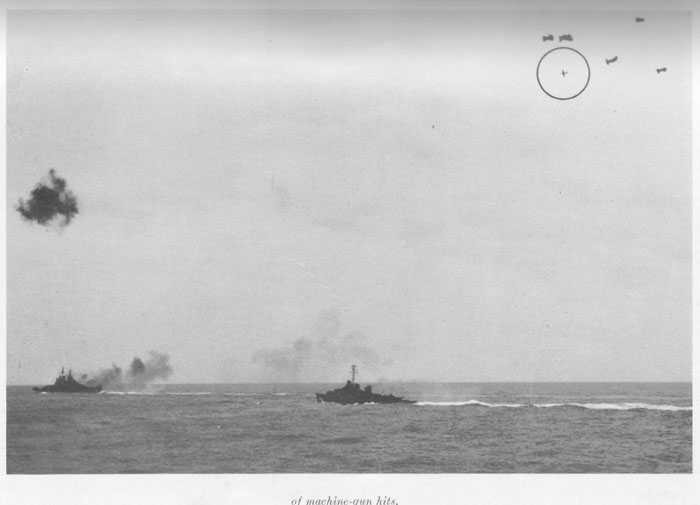
--81-c--
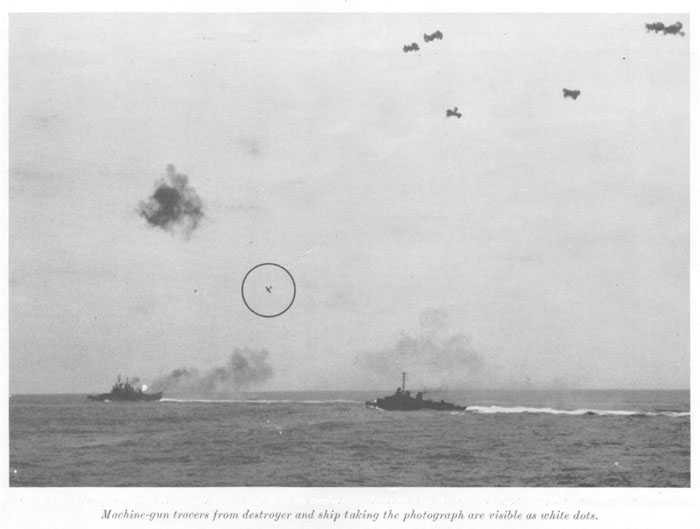
--81-d--
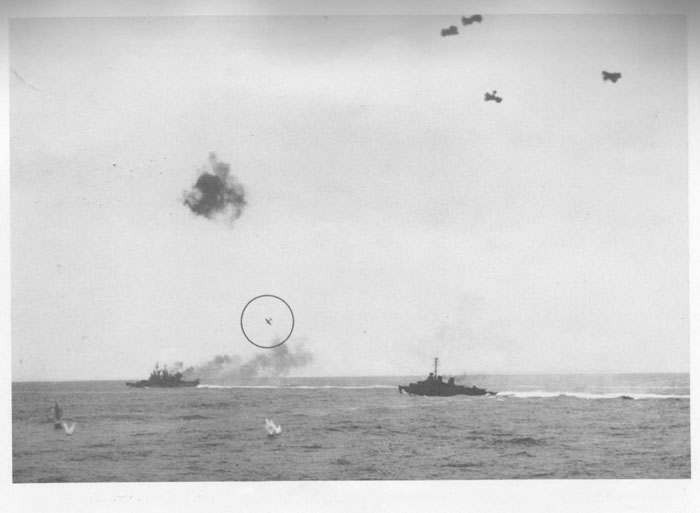
--81-e--
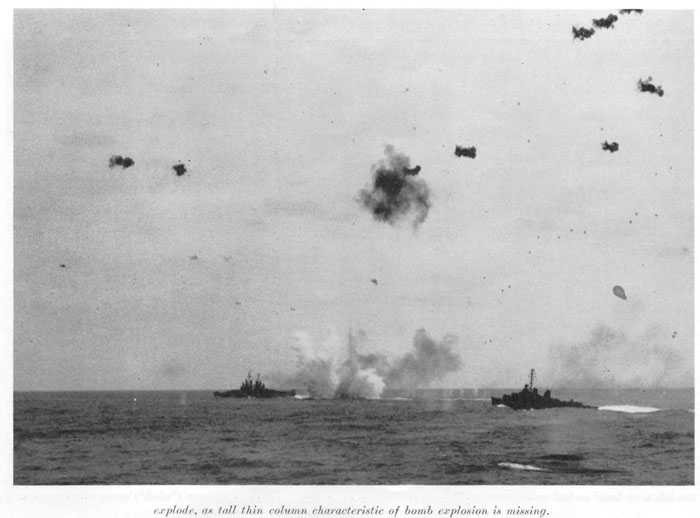
--81-f--
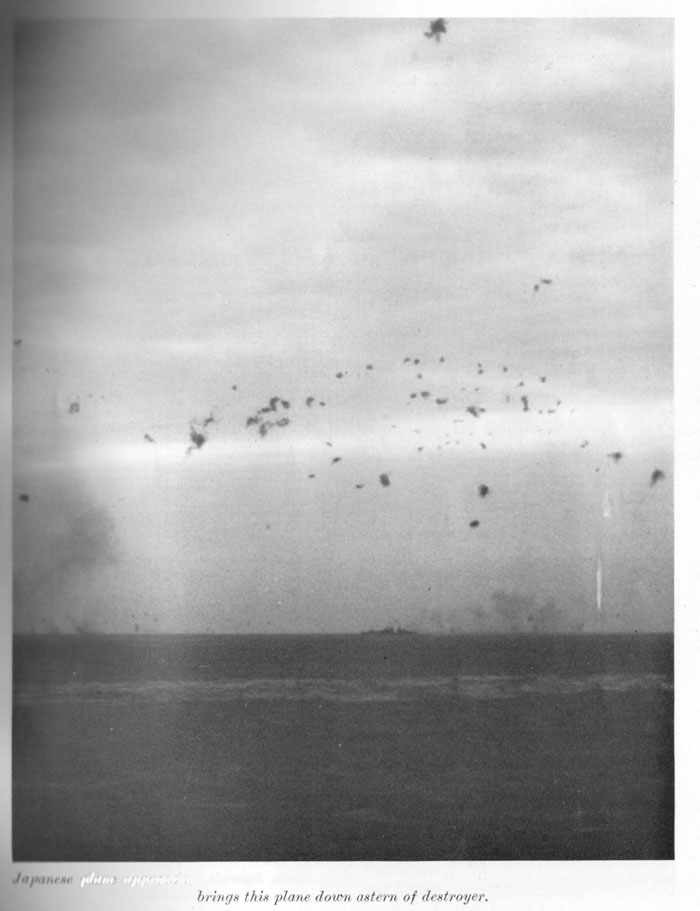
--81-g--
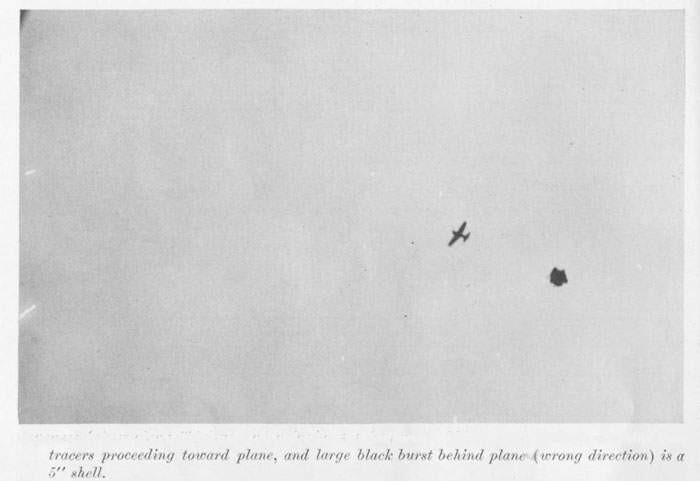
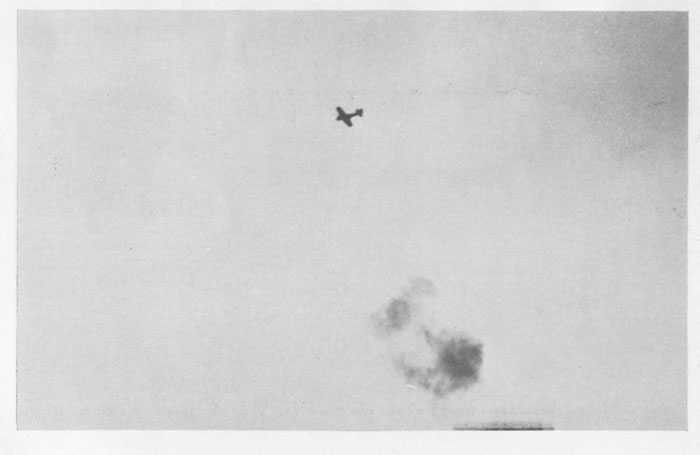
--81-h--
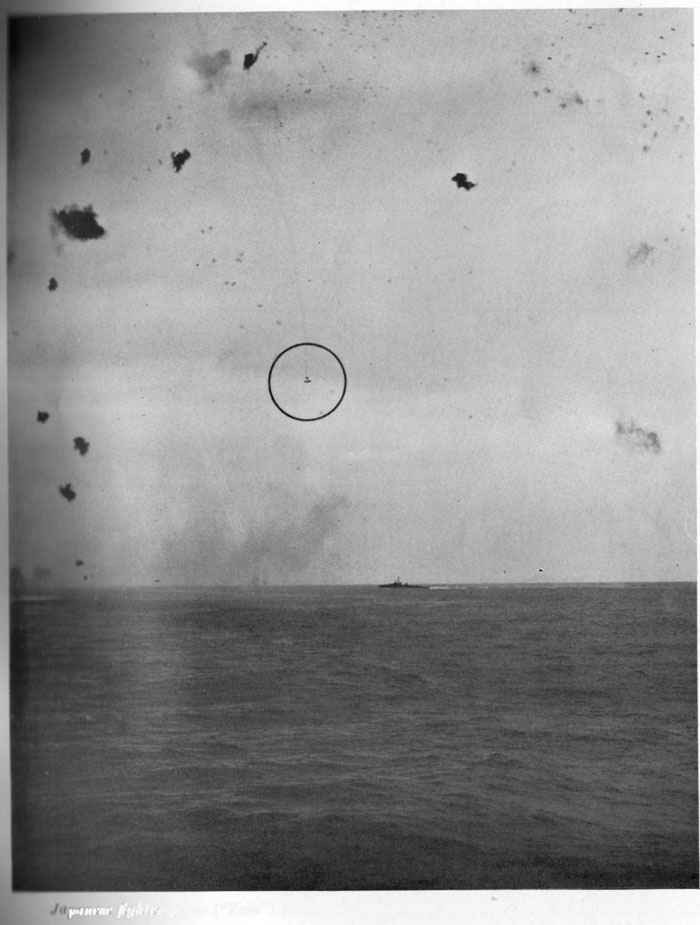
--81-i--
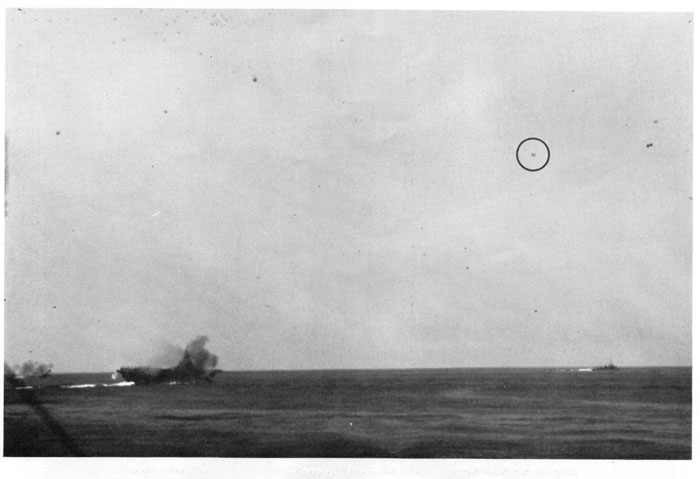
--81-j--
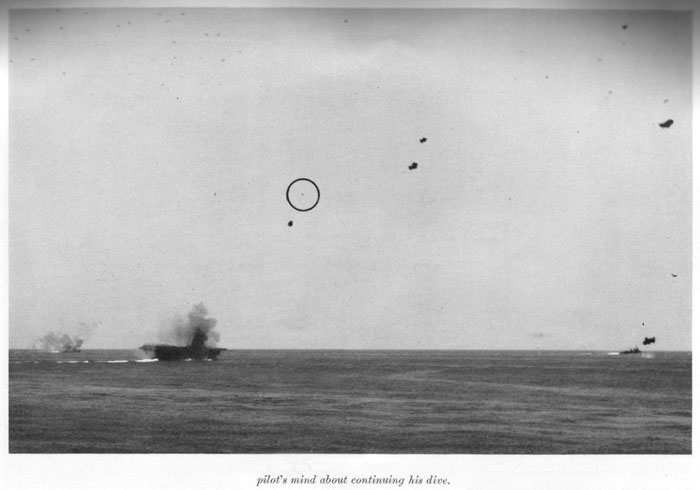
--81-k--
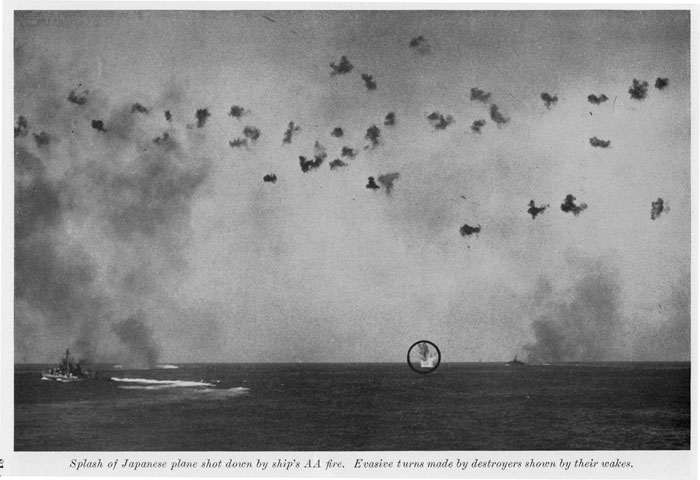
--81-l--
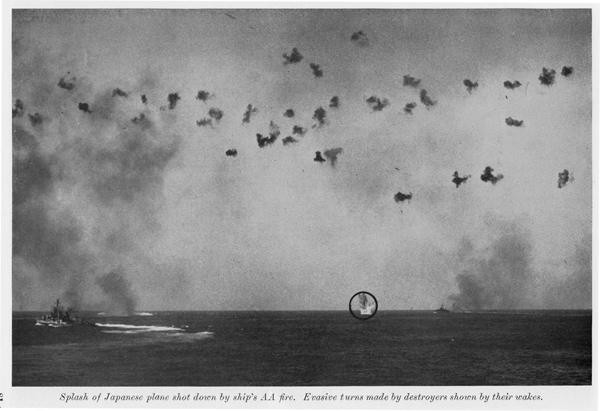
--81-m--
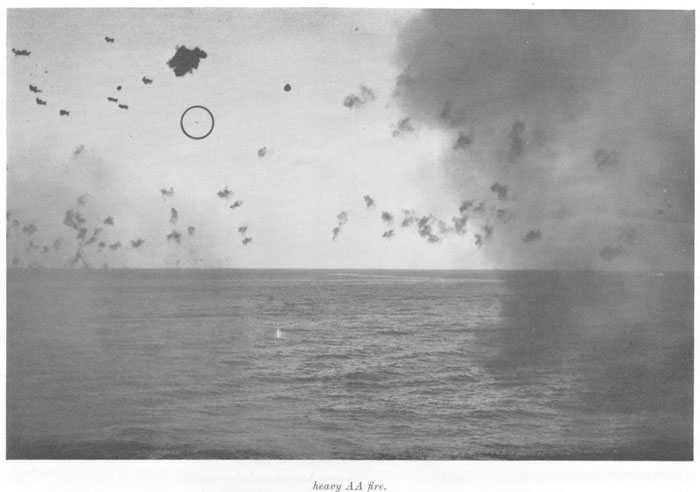
--81-n--
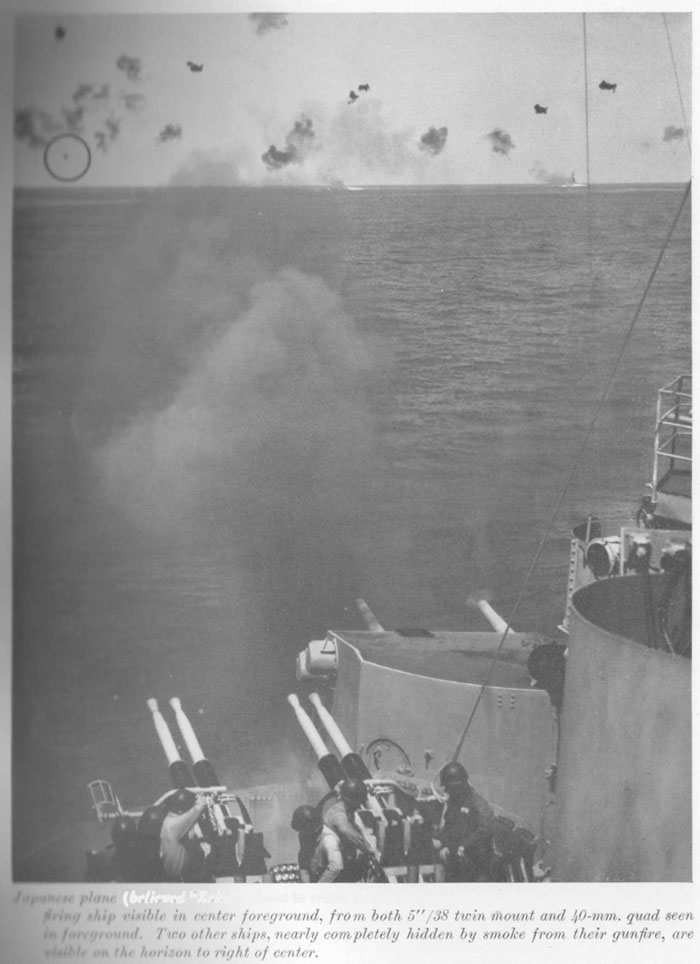
--81-o--
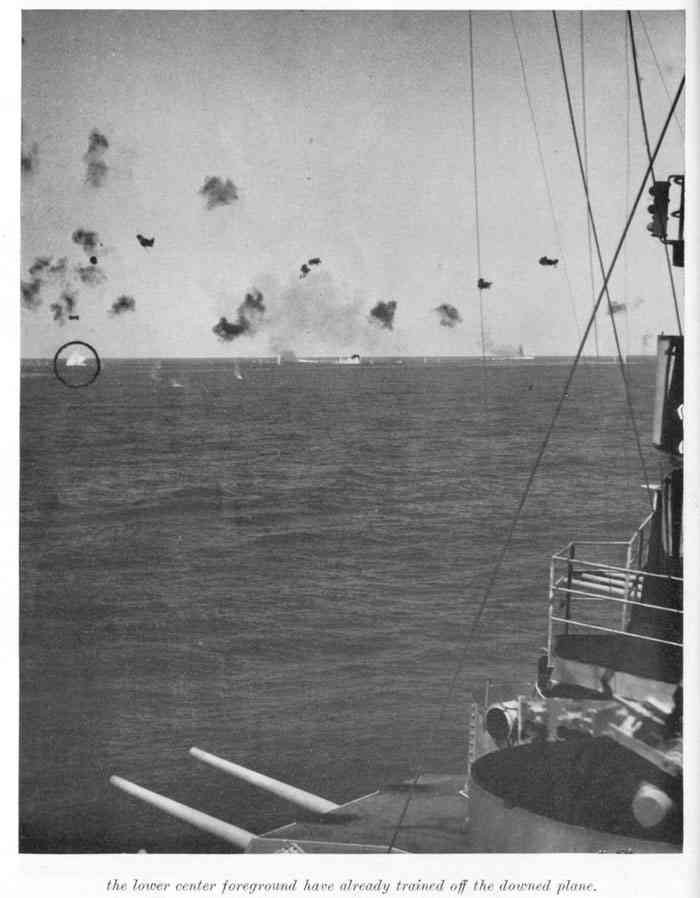
--81-p--
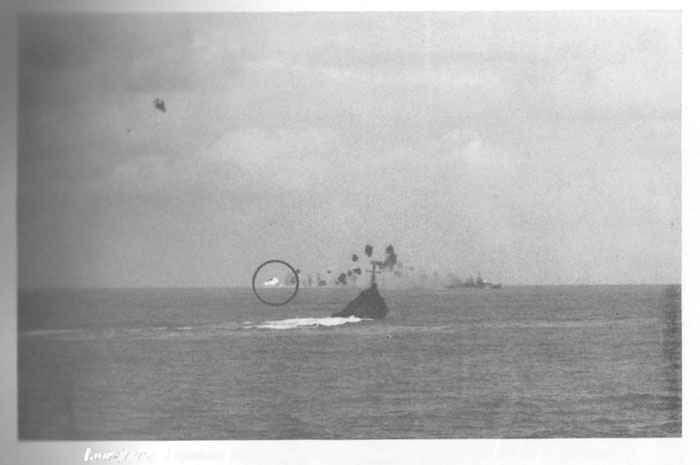
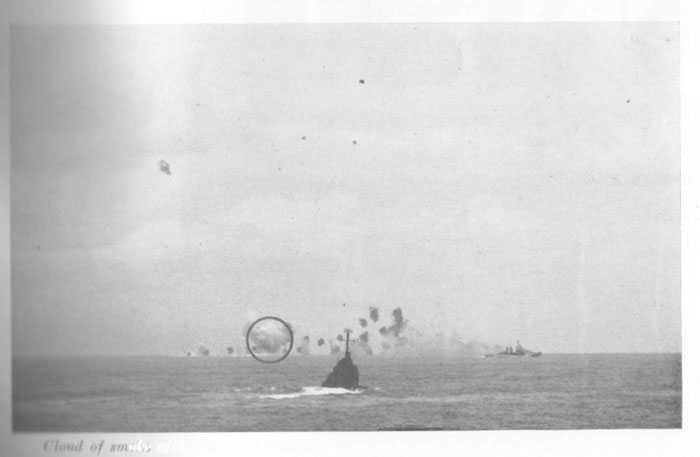
--81-q--
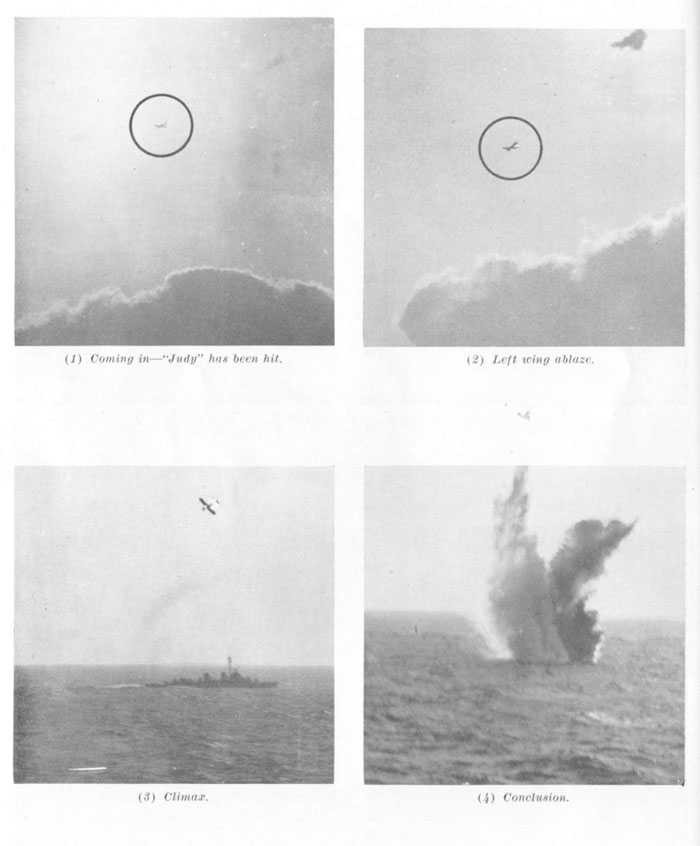
--81-r--
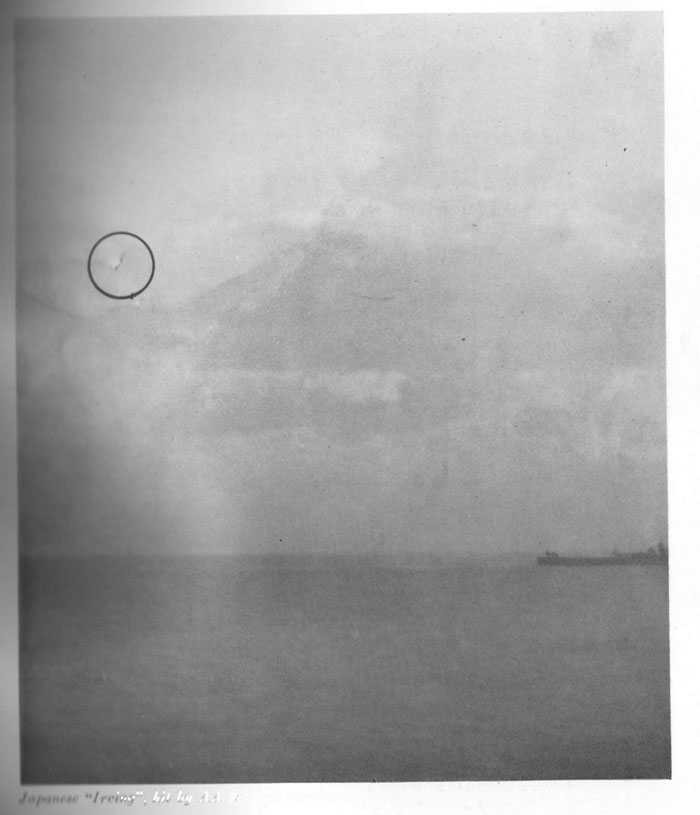
--81-s--
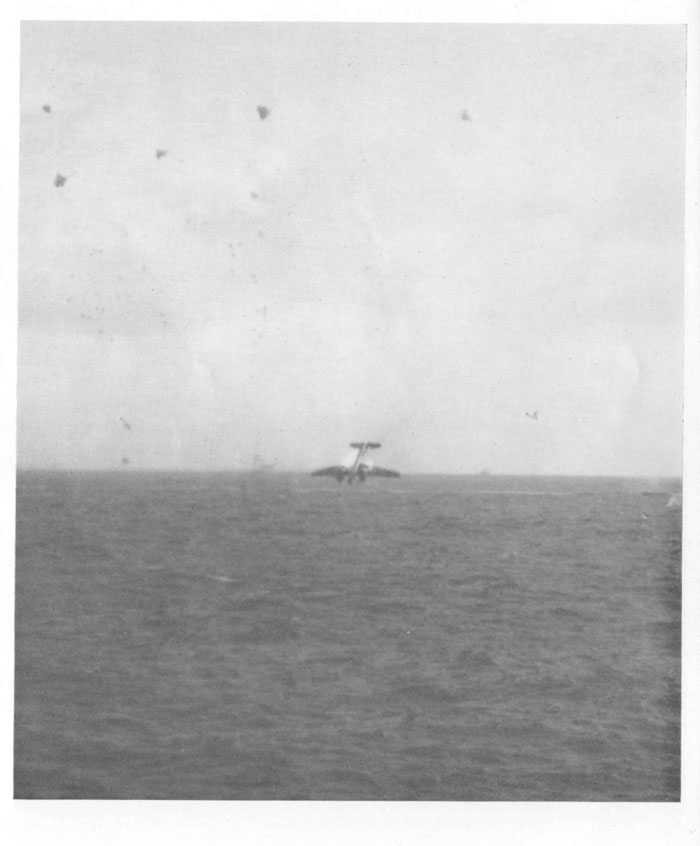
--81-t--
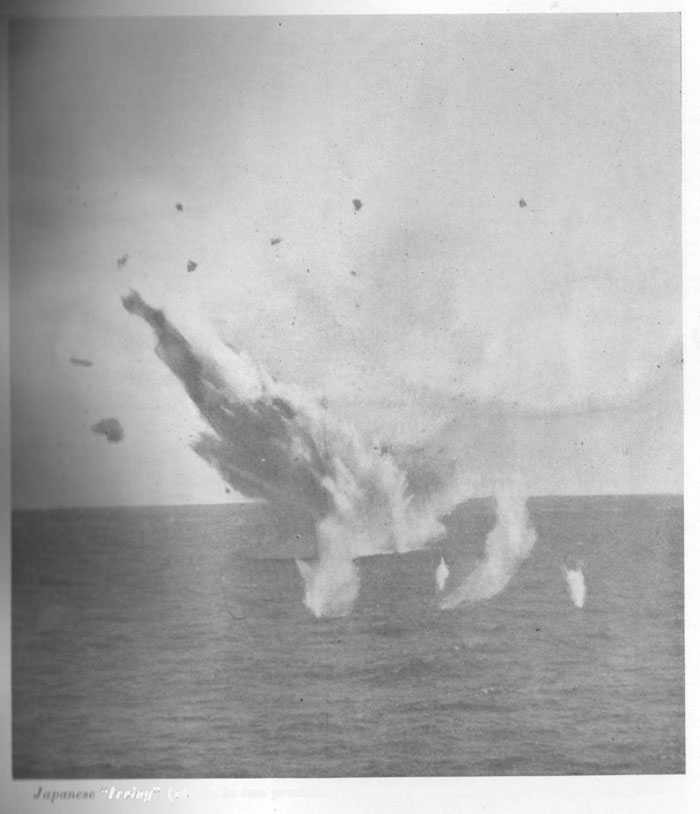
--81-u--
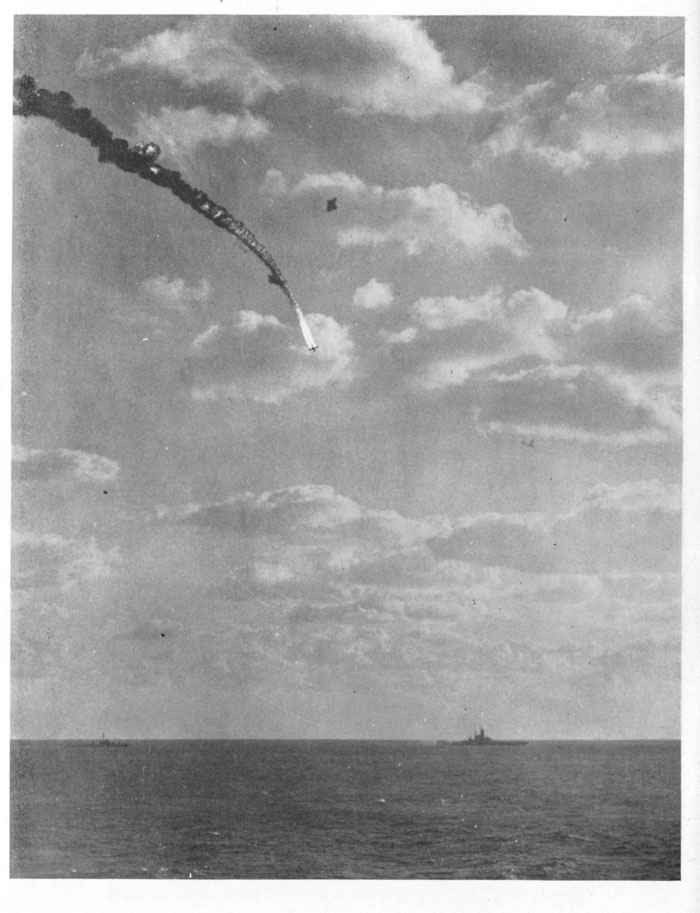
--81-v--
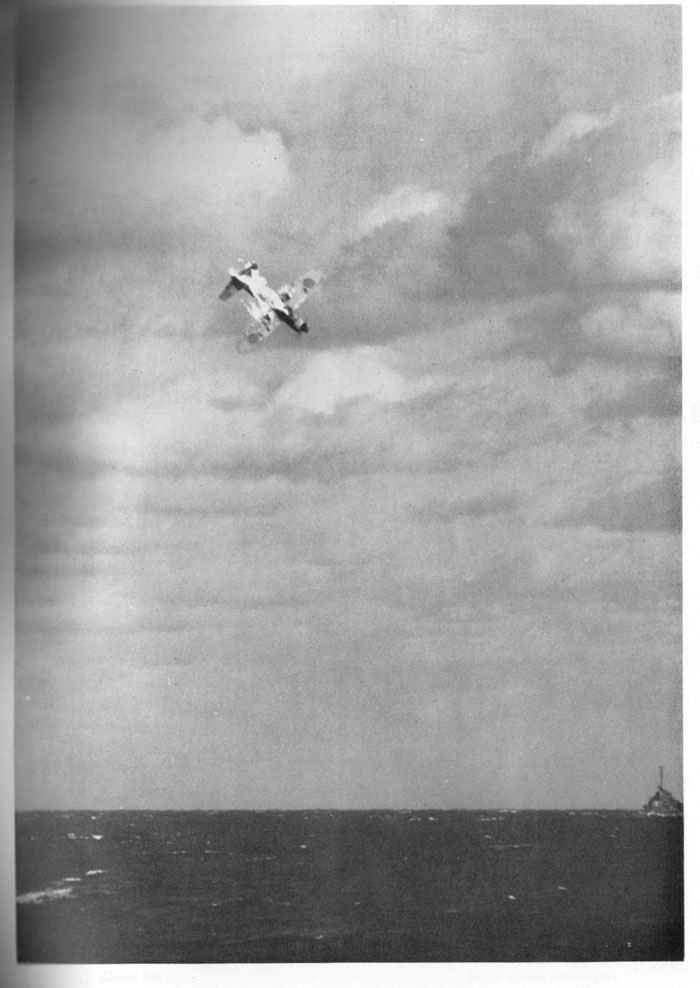
--81-w--
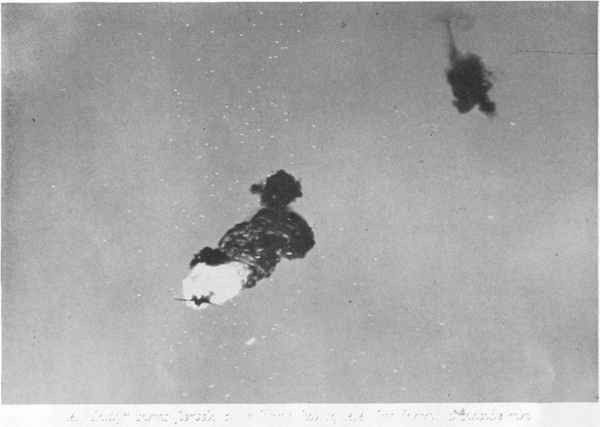
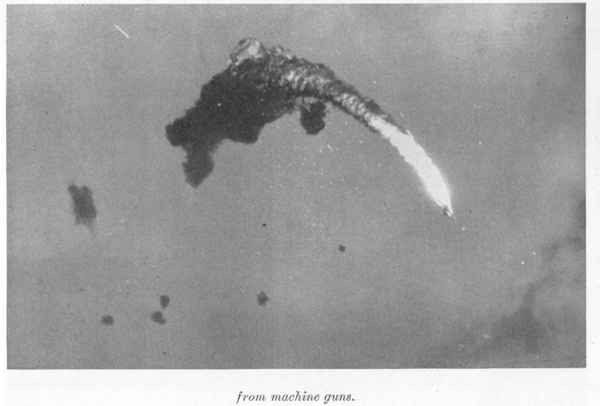
--81-x--
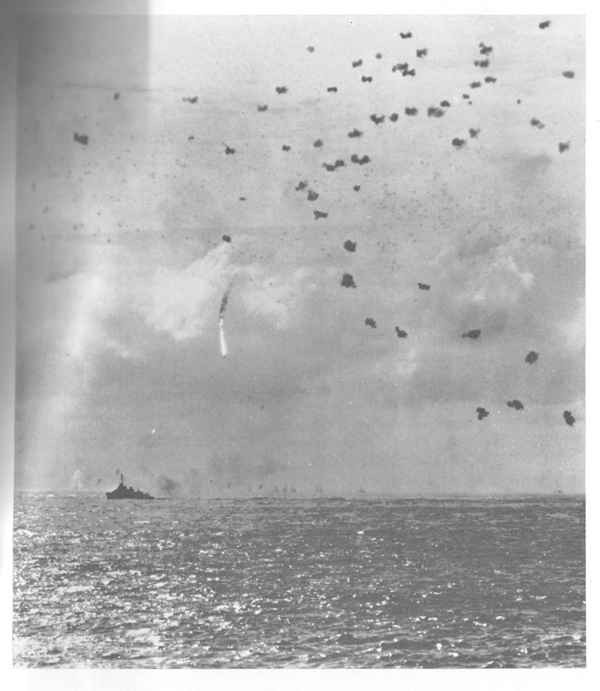
--81-y--
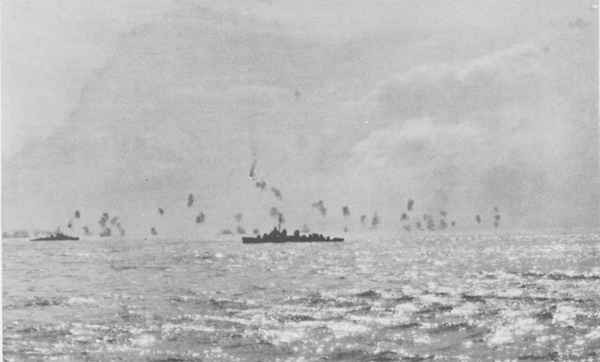
--81-z--
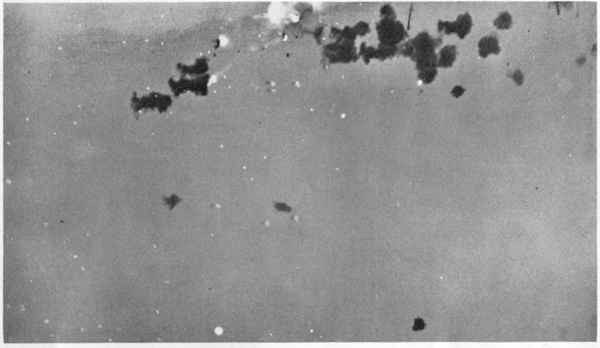
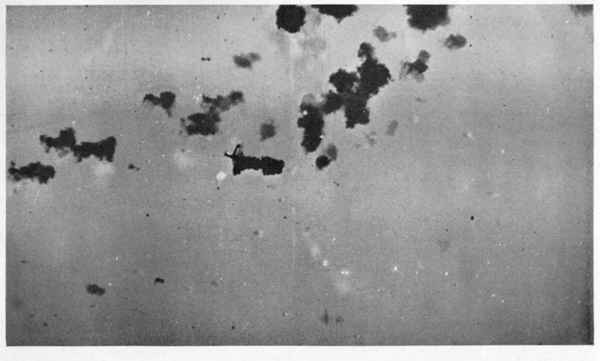
--81-aa--
[Blank page]
--81-bb--
COMMENTS, LESSONS LEARNED,
RECOMMENDATIONS AND CONCLUSIONS
BAKA BOMB
CO USS Hugh V. Hadley comments:
The ship was put out of action by a Baka Bomb. It was released from a large lumbering BETTY which came in from astern during the final attack, altitude about 600 feet. The bomb appeared to be about one and one half times as large as a 21" torpedo. On each side were very short stubby wings about one-third the usual normal wing length of a plane. There was no engine. The bomb struck the ship on the starboard side at frame number 105, which is the bulkhead between the after engine room and forward fireroom. The explosion from this bomb was terrific and some decks were lifted about 20 inches causing ankles and knees to be broken or strained. Three large engineering spaces were immediately flooded and the ship settled in the water rapidly.
THREE LARGE ENGINEERING SPACES WERE FLOODED BUT THE SHIP WAS SAVED. THE TRAINING AND FAMILIARIZATION OF EFFECTIVE DAMAGE CONTROL PROCEDURES BY THE ENTIRE CREW WERE DEMONSTRATED IN THIS ACTION. IT WILL BE REMEMBERED THAT THE DAMAGE CONTROL PARTIES WERE FIGHTING RAGING FIRES, EXPLODING AMMUNITION, AND FLOODED COMPARTMENTS, AND TAKING CARE OF THE WOUNDED.
Another result of this explosion was to put all equipment including the 5" guns out of action.
COMBAT AIR PATROL
CO USS HUGH V. Hadley comments:
It can be recorded that the aviators who comprised the Combat Air Patrol assigned to the Hadley gave battle to the enemy that ranks with the highest traditions of our Navy's history. When the leader was asked to close and assist us, he replied, "I am out of ammunition but I am sticking with you." He then proceeded to fly his plane at enemy planes attacking in attempts to head them off. Towards the end of the battle I witnessed one Marine pilot attempting to ride off a suicide diving plane. This plane hit us but not vitally. I am willing to take my ship to the shores of Japan if I could have these Marines with me.
IT WAS UNFORTUNATE THAT WE HAD AN INSUFFICIENT NUMBER OF FIGHTER PLANES TO DO THE JOB AT HAND.
CTF 58 comments:
Experience gained in this operation indicated that with improved radar equipment the radar patrol line operating 30 to 40 miles in the direction of the enemy will be able to detect and destroy low-flying enemy planes before they sight the main force. This may very well be the answer to the suicide plane. For the present, planes approaching above 10,000 feet will be handled by the CAP over the task group. However, it is conceivable that with the introduction of SP radar, the radar patrol line will be able to handle a greater number of interceptions. If this condition materializes, a greater percentage of the CAP will be turned over to the radar patrol line FDO.
COMBAT INFORMATION CENTER
COMMUNICATIONS
CO USS Purdy comments:
1. With the installation of the Mk. 63 fire control system, combat assumed an additional responsibility of coaching the automatic weapons radars on targets. As originally planned, communications between Mk. 28 radar operator and the Mk. 37 director operator (Mk. 12 radar) were led into combat at a toggle switch. At the time of installation it was impossible to determine which would be most feasible - coaching the 40MM on target by using the JW circuit or by using the 41 JS circuit. Consequently, both circuits were led into the toggle switch box in addition to the 49 JY-1, 49 JY-2, 49 JY-3, and 49 JY-4.
2. As the Evaluator was continually giving a Navigational picture, checking station keeping, and keeping Battle One (Commanding Officer and CDD 126) informed as to the general picture, the gunnery officer frequently lacked vital and up-to-the-minute information concerning fast-moving air targets. In the process of experimenting with JA, JW, JY, 41 JS circuits the JW-JY combination proved most satisfactory and most easily set up (via toggle switches in CIC) for rapid and satisfactory communications of the over-all gunnery coaching circuit for air attack.
--81-19--
3. With the circuits correctly crossed, the following stations receive the vital air information simultaneously and with no delay directly from combat - 5" battery Control Officer (JW), Air Defense Officer (49 JY-1), No. 1 Quadrant Auto-Weapon Officer (49 JY-1), No. 2 Quadrant Officer (49 JY-2), No. 3 Quadrant Officer (49 JY-3), No. 4 Quadrant Officer (49 JY-4). 40MM quad Mount 43 Radar Operator (49 JY-3), and 40MM quad Mount 44 Radar Operator (49 JY-4).
4. Considering the above, it was decided to cross the JW-JY circuits during operations when enemy air attacks assumed high priority. The Intercept Officer (air plotting officer) in combat manned the JW crossed with the special JY hook-up and constantly informed all weapon Control Officers (5", 40MM, and 20MM battery) of the air situation. The Evaluator shifted to the JA (surface lookouts remained on JA) and continued designation of dangerous air targets and presentation of the general situation.
5. The above communication arrangement is used only for air attack. In the event of possibilities of combined surface and air attack, communications will remain as outlined in standard 2200-ton type DD CIC organization.
6. External communications for large operations present a difficult problem for CIC; namely, a lack of personnel to properly guard the circuits. The optimum is reached with a sufficient number of personnel to man all external voice circuits in CIC with headset, thus reducing the noise level. Competent enlisted personnel under the supervision of the Communication Officer, stationed in combat, provide very good talkers for the many circuits. To coordinate internal and external communications the JX circuit is manned in the following spaces: Signal Bridge, CIC, Main Radio, Battle One, and Emergency Radio Room. CIC is the filter for all communications under supervision of the Communication Officer who is normally stationed in Combat.
EQUIPMENT
CO USS Stanly comments:
1. Just prior to the period covered by this report, additional radio equipment was installed in CIC and radio central in order to handle all phases of destroyer fighter direction. All equipment functioned well and remained in operating condition even after the ship had been hit by a suicide plane and shaken badly by a plane that crashed just off the port bow. SGA and SC-4 were in full operation during and after the attack. The Mark 12 antenna was hit by shrapnel when the suicide plane crashed into the ship, but the remainder of the installation was completely operational.
2. The noise level in CIC became excessive when ship's tactical and fighter direction circuits were in use.
EVERY EFFORT SHOULD BE MADE TO MONITOR SUCH CIRCUITS WITH HEADPHONES.
FIGHTER DIRECTION
CO USS Bush comments:
The Bush had a special Fighter Direction Team embarked throughout the operation. This team was assigned control of aircraft at four different times for short periods. No records are available but the following are noted:
(a) Fade charts for SC-2 radar were fairly accurate for altitude determination and with the Mk. 4 picking up targets at 24 miles early estimates of altitude were possible.
(b) Single enemy planes apparently on weather and reconnaissance flights seemed to approach in the clouds and although CAP was stacked at "mattress" and "quilt" it was difficult in cloudy weather to make interceptions.
(c) The aforementioned single aircraft were tracked at high speeds and in one case when "Tally-Ho" was made by BushCAP the F6F's could not catch up with the enemy plane even though using maximum speed,
INFORMATION OF THIS NATURE IS HIGHLY IMPORTANT FOR FIGHTER DIRECTION OFFICERS. BEFORE A FIGHTER DIRECTION OFFICER CAN PERFORM HIS DUTIES EFFICIENTLY, HE MUST HAVE FULL KNOWLEDGE OF OWN AND ENEMY PLANES' CAPABILITIES.
(d) In the afternoon on which the ship was sunk, control of four aircraft was passed to Bush after the raids had been picked up and had closed to 25 miles. A quick vector resulted in interception of
--81-20--
Raid One but there were not enough planes to handle all four raids.
AGAIN TOO FEW PLANES TO DO THE JOB AT HAND.
(e) At other times when control of a CAP was passed to Bush it was already too late to make an interception; the enemy had in most cases passed and was headed for the transport area.
THIS CONDITION WOULD SUGGEST THAT THE SYSTEM WAS IN ERROR OR THERE WAS A PERSONNEL FAILURE.
(f) Visual fighter direction was ordered by the commanding officer in the afternoon of the 6th when it became apparent that the raids were headed for the ship in Radar Picket Station No. 1 as evidenced by their tracks. CIC and the Fighter Direction Team were in the process of carrying out the order when the ship was hit.
CO USS Mullany comments:
1. The OKINAWA operation has proven to be one demanding the utmost from radar and fighter direction doctrines. With sometimes as many as a dozen raids threatening at the same time and from both north-westerly and south-westerly directions, the reporting, interception, and splashing of the enemy has been well controlled and thorough. The stationing of pickets has resulted in complete radar coverage allowing very few "bogies" to penetrate the screen undetected. Most of the bogies approached low over the water, making early detection difficult. It is believed that enemy planes were landing on NAHA airfield during the initial stages of the operation, as "bogies" which appeared on the screen after dark would be tracked to the perimeter of OKINAWA and would then be lost without report of their being shot down.
2. The CAP has done an excellent job in keeping the figures high in the "splash" column, flying in difficult weather and until dark in several instances. The night CAP has proven valuable in many interceptions, but there is still much to be desired if control of the air at night is to be obtained. Night fighters were airborne occasionally with no attempt made at intercepting the night "hecklers". This shows a need for more specially trained intercept officers in the forward areas. With two operational airfields and qualified intercept officers present, there should be no excuse for not utilizing the night fighter to the utmost. Fortunately the Japs did not see the capabilities of a full-scale night bombing attack on KERAMA RETTO, where the anchorage was filled with damaged ships and other high-priority targets.
3. Special praise is in order for the FDO's on the Eldorado. The IFD net was very effectively used in handling the reports and assigning interceptions. At many junctures the patience of the FDO was strained by stations cutting in on his net, demanding air cover and making criticisms of the way a situation was being handled. Responsible parties should realize the FDO's job is not an easy one when large scale air attacks are forming. He is not required to provide air cover for every station when requested to do so.
THE FDO MUST GET SUFFICIENT PLANES TO THE PROPER SPOT. WERE THERE TOO MANY INDIVIDUAL UNITS TO BE EFFICIENT? SEE CIC CONTROL DOCTRINE, USF 10.
CO USS Purdy comments: 1. 6 April 1945:
At least one raid in the immediate vicinity of the Purdy (patrol stations A-4 and A-5) was stopped on this occasion by CAP, and the work done by VF on the western side of the island was apparently magnificent. Splash reports were coming at the rate of one every 2 minutes for 2 hours before the ships to the east of OKINAWA were under attack, and CAP were still doing a good job in that area at the time the Mullany was hit. The Purdy, however, did not know at this time whose fighters were around her or who was controlling.
IFD and LAW reports throughout the period 1-12 April were excellent. Ships with no air search radars at all were able to keep a very clear picture of air attacks in progress, and CIC on the Purdy on one occasion was able to coach the Mk. 12 radar on a closing air raid not picked up on its own SC-3. (This raid, however, opened out and was not taken under fire). The FD Evaluation and controlling by the FDO was good to excellent throughout the attacks observed.
--81-21--
2. 12 April 1945.
On this occasion the Purdy was assigned as support to the Cassin Young on Radar Picket Station 1. It was thought possible that the Purdy might be called upon to take control of RP 1's CAP at any time, so great care was taken to keep track of the planes involved. At 1200 on 12 April, as during most of the two days preceding, the CAP controlled by the Cassin Young consisted of 2 divisions. Both the CASSIN YOUNG and the Purdy were under air attack shortly after 1320, when the CAP was about due to be relieved, and one vector was heard given to one division of the fighters, apparently being sent out to aid the USS M.L. Abele (DD733) at RP 14 or to stop one of the raids to the west. Just what happened to the CAP after that is not clear to the Purdy, but there was a period around 1330 when no friendly planes were found on the Purdy'S SC-3 in the vicinity of RP 1. Shortly after that a suicide plane took off the Cassin Young's SC antenna and the Purdy attempted to assume control of the CAP. The divisions which had been up since 1200 were finally contacted some 80 miles to the South and West, and when contact was finally made with CAP it was a division of F4U'S from the Bunker Hill which had been sent to RP 12 and had been tangling with the Vals over RP-1 under control of the Hudson (DD475).
These planes were vectored (by Purdy) 020 at altitude of 3000 feet and effected a tallyho on 2 bogies 15 miles to the northeast of the Purdy at about 1500. Results were not observed as the Purdy was hit at 1503 and lost communications. At least one division of F6F's and 3 FM'S were observed over the Purdy during the last attack, but communications were not established and only 5" burst firing could be used to direct these planes to incoming raids. It is estimated that about 30 planes attacked RP-1 between 1300 and 1510 and CAP accounted for over half of these, both with and without control by FD destoyers.
After getting search radars and VHF radio back in operation (around 1530), the Purdy attempted to contact the planes she had briefly controlled without success, but one division of F4U'S (also apparently from the BUNKER HILL) was contacted and remained over the Purdy and STANLEY (DD478) as air cover until both ships reached the transport area.
CO USS Sterett comments:
1. The Sterett was stationed in radar picket station number 4, on 9 April 1945 for radar guard and fighter director duties. Few bogies were picked up during the day. A complete track of all friendlies in the area and station controlling was kept. Communication with Force Fighter Director in the Eldorado was difficult and all reports were relayed through the Cassin Young who was stationed in radar picket station number 1.
2. At 1831 a raid of 3 to 5 planes was picked up bearing 033° - 58 miles closing on course 240°. They later changed course to 210° and closed rapidly at speed of 175 to 185 knots. The estimated angels of the raid was 2000 feet. TheCassin Young in radar picket station No. 1 was attempting an interception at an extreme range. Her planes were 10 miles to the west of the ship on course 110° and the bogies were 15 miles to the northeast. The fighters were called by the assistant evaluator in an attempt to take over control and vector them on course 090° for an interception. When the bogies had closed to 10 miles the attempt to contact the fighters was abandoned and control was coached onto the target. This interception is thought to have been called off due to extreme range of controlling ship. However, friendly fighters were observed in the area at the end of the attack.
EVERY EFFORT SHOULD BE MADE TO PASS CONTROL OF CAP TO THE SHIP WITH THE BEST POSITION AND INFORMATION TO MAKE THE INTERCEPTION. SUCH FLEXIBILITY IS IMPORTANT AND SHOULD BE EMPHASIZED IN PLANS AND TRAINING.
3. When the raid was at 8 miles from the ship they were picked up on the Sugar George and control was put on target at 8000 yards. Four targets appeared on the Mk-28 scope and the leading plane was noticed by the operator to draw off from the rest of the formation. This plane came in a shallow dive for the ship while the others appeared to climb as they disappeared from the Sugar George scope.
4. The FFD was informed of the ship being attacked and the message was receipted for before the first plane was splashed, but the plane diving on the ship hit on the starboard side at the
--81-22--
waterline directly below CIC, cutting off all power to the radars and radios. Eight men of the CIC General Quarters crew were then directed to report to the repair parties while the Assistant Evaluator and two men stood by CIC. Another attempt was made to reach the Cassin Young's planes on the 233A on both channels 2 and 4 with no success.
5. The SCR-808 was put back into commission and an attempt was made to establish contact with any ship on the following channels: 34.8 mgs., 37.6 mgs., 36.2 mg., and 38.7 mgs. with no success except to LCS's in the immediate area who were also under attack.
6. Destructors were placed in the BK's and the fire axe broken out for quick destruction of the radar receivers. After the raid, power was restored to the radars by an emergency cable led up from below and the SG, SC, and BL were put back into operation. The shock of the explosion damaged the BL to the extent that it would go out of commission intermittently and the SG did not have a 15,000 yard sweep. The gyro leads were cut and both radars had to be operated on relative bearing search. On the retiring course, the ship's position was plotted frequently by range arcs from known points of land on the island of OKINAWA.
7. A two-watch system was again set up in CIC after the attack and the work of CIC went on again as usual. Throughout the attack all hands of the CIC general quarters crew acted calmly and with quick decision. All radars were secured after loss of power and before new fuzes could be installed that would send a damaging surge of electricity through the equipment. Evacuating of CIC when it was of no more immediate use was orderly and without confusion.
IFF PERFORMANCE
CO USS Purdy comments:
1. In general, the greatest offenders of IFF doctrine were the PBM's. One common phrase over IFD circuit is "Tallyho one friendly PBM". The Purdy was closed once only by a friendly showing no IFF.
REPEATED FAILURE TO USE IFF AFTER SO MANY WARNINGS SEEMS TO WARRANT DRASTIC CORRECTIVE MEASURES.
2. Much reliance is placed on IFF with the great multitude of aircraft present at all times. With experienced operators, friendlies mixing with enemies are easily discernible. At no time did combat fail to impress upon bridge, lookouts, or gun control the location of enemy planes, as all friendlies were showing IFF. If the enemy is making any attempts at reproducing IFF signals, none has so far been apparent to this vessel.
3. The writer is of the opinion that, with numerous surface craft in the area, greater effort should be expended to insure that all BK's operate correctly. On several occasions valuable time has been wasted identifying friendly surface craft when correct operation of the BK would have sufficed.
RADAR COUNTERMEASURES
CO USS Bush comments:
1. Records were lost but it is remembered that at various times while on radar picket station enemy radar signals evaluated as emanating from shore-based air search radar were reported by Bush to CTF 51.
2. No radar jamming was experienced.
On the evening of 3 April at about 2200 a group of enemy planes closed and dropped window around the ship at a range of ten to thirteen miles, completely blocking the SC-2 screen. The window appeared on the Mk-4 screen and only by judicious tracking was gun control able to distinguish between true and false targets. The window dissipated in about 20-30 minutes.
THIS INDICATES THAT THE JAPANESE ARE BECOMING MORE PROFICIENT WITH THE USE OF WINDOW OR THAT OUR OPERATORS NEED MORE TRAINING. JAPANESE KNOWLEDGE OF OUR RADAR FREQUENCY SET-UP IS INCREASING.
Raid No. 1 of the afternoon of 6 April dropped some window but not extensively enough to hamper operation of the SC-2 or Mk. 4 radars. Use of window in high visibility at close range seems to offer no advantage to the enemy and its use is not understood.
--81-23--
USS Stanly RCM OFFICER reports:
1. RCM Underway Team #4 reported aboard USS Stanly on 21 March 1945, for temporary duty in accordance with orders, to train personnel in the operation of the RCM installation.
2. The RCM installation had just been completed by personnel from USS PRAIRIE. After checking over installation, training of personnel commenced on 25 March 1945. Preparation for getting underway for OKINAWA operation limited training opportunities very greatly. In addition, the number of radar operators in ship's company was found to be hardly sufficient to perform regular duties and still obtain training under a regular schedule once the ship got underway. Training of personnel in the operation of equipment was impracticable once the operational area was reached due to frequent general quarters and condition watches. Before entering the operational area I lectured on and discussed with the officers matters relating to RCM doctrine, CIC duties, and required reports.
3. Since training was impracticable once the operational area was reached, my enlisted personnel were organized to stand intercept watches, using TN-2, covering 75 - 300 mcs, and were prepared to jam upon orders to do so. Continuous intercept watches were maintained until the ship reported to KERAMA RHETTO for repairs on 12 April. I was available to CIC during this period in the event any RCM questions came up.
4. No jamming of enemy radar was attempted by this ship. A number of radar signals believed to be enemy were intercepted and reported in accordance with Pacific Fleet Confidential Letter 7CL-45. During the attacks on this ship on 12 April, no enemy signals were intercepted. The signals intercepted and reported are listed as follows:
11301200183519101725140018451915000509301115
| ZEBRA TIME | DATE | LOCATION OF SHIP | SIGNALS |
|---|---|---|---|
| 31 March | 25 00' N, 127 48' E. | 162/500/15- 18 | |
| 31 March | 25 00' N, 127 48' E. | 404/2000 or greater | |
| 31 March | 25 56' N, 127 44' E. | 97/300-400/30-40 | |
| 31 March | 25 56' N, 127 44' E. | 160/1600/2-3 | |
| 02 April | 27 35' N, 126 59' E. | 212/1500-2000 Unobserved | |
| 04 April | 27 25' N, 126 59' E. | 190/700-1000/4-8 | |
| 05 April | 56 40' N, 127 40' E. | 74/450/30-35 | |
| 05 April | 26 40' N, 127 40' E. | 97/400/35 | |
| 06 April | 26 55' N, 127 06' E. | 202/60 or 70 in excess 100 | |
| 06 April | 25 45' N, 127 18' E. | 202/-/20 | |
| 08 April | 26 00' N, 127 09' E. | 221/600-650/12-15 |
The use of window by enemy planes a number of times prior to 12 April was noted on both the SC and Mark 12 radars. Apparently window was dropped to cover the retreat of the plane, since in each instance the plane came in, dropped window and immediately retreated. The window was not very effective and could be read through in all cases.
RADAR COUNTERMEASURES GEAR
CO USS Colhoun comments and recommends:
1. The RCM gear as installed gave satisfactory performance. In one case, by detecting a friendly airborne radar signal when plane was not showing IFF, it kept us from opening fire on a friendly plane. It also established the fact that enemy shore-based radar was located on YURON SHIMA. No enemy airborne radar was detected.
2. It is recommended that a Gyro repeater be installed in RCM shack at first opportunity.
RADAR - MAINTENANCE OF
CO USS Purdy comments:
As previously stated, radars at all times were operating in a satisfactory manner. There was no evidence that weather conditions affected the radar performance adversely.
--81-24--
PROPER MAINTENANCE IS VITAL TO SATISFACTORY PERFORMANCE.
RADAR OPERATIONAL TECHNIQUES
CO USS Purdy comments:
The following type SC-3 operation combined with SG operation for tracking of air targets was found satisfactory: One air plotter wears 21 JS phones to SC-3 operator and to the Radar Control Officer on the remote PPI; a second air plotter wears headset on Local Air Warning (LAW) circuit; SC-3 operator wears 21 JS phones; the stand-by SC-3 operator scans "A" scope for close-in targets over land, etc. The Radar Control Officer mans remote PPI and wears 21 JS to coordinate SC-SG information (aids in, identifying possible air targets from land or surface ships). At the same time an accurate surface picture is maintained using the normal 22 JS circuit from SG operator to surface plot recorder.
RADAR - PERFORMANCE OF
CO USS Murray comments:
It is interesting to note that during the night action of 20 March, when the Japanese plane dropped window and then approached on the approximate bearing where the window was dropped, the Mark 12 radar operator experienced no difficulty in determining which was the target.
PROPER MAINTENANCE OF EQUIPMENT AND TRAINING OF OPERATORS RESULT IN MAXIMUM EFFICIENCY OF PERFORMANCE.
CO USS Purdy comments:
1. All radars at all times were performing in a satisfactory manner. The Sugar Charlie contacted raids at ranges of 50 to 70 miles when flying at angels 5 or higher. The Sugar George would pick up low-flying planes in some instances at 16 miles. It is believed the Fade Chart for Sugar Charlie is reasonably accurate.
2. As the Japanese were approaching at low altitudes, Sugar George proved to be very valuable. The following method of tracking was used in Combat by the Purdy: Maximum gain was used on the SG-1 with continuous rotation of the antenna. The Summary plotter, who keeps a continuous surface plot, appeared to most readily discover new targets (planes). Surface tracking was maintained by casual plotting.
THIS IS A GOOD EXAMPLE OF THE VALUE OF AN ALERT, COMPETENT SUMMARY PLOT SYSTEM.
3. The tracking of surface targets was neglected to some degree due to the interest of air targets. Standard air search procedure was used on short scale when enemy planes were known to be in the immediate vicinity. To air targets not on own radars the following system has been used since arrival in the OKINAWA area: One man, stationed on the LAW circuit with head set, records all data which is then plotted on the air plot. The fire control radar was coached on several raids previously undetected by own radars, using this system.
4. Radar navigation was incidental during air actions but for night retirements and patrolling in restricted areas a constant check was necessary. Errors in discrimination are very small due to the geographical characteristics of the RYUKYU ISLANDS. Furthermore, it may be mentioned that while patrolling station 155, RUKAN SHO reef presented itself on the Sugar George at a range of about 4000 yards giving a complete picture of the reef. Sound gear was an invaluable aid in checking navigation around reefs and was used for this purpose.
5. Station keeping at night was in accordance with standard doctrine. The Purdy uses the following standard doctrine for station keeping: Combat is primarily responsible for surface units outside of 1000 yard range and the O.O.D. is considered primarily responsible for units inside of 1000 yard range.
THE WORK OF OUR LIMITED AVAILABLE ELECTRONIC TECHNICAL PERSONNEL IS GRATIFYING. CARE SHOULD BE EXERCISED IN PLACING THEM IN MAINTENANCE RATHER THAN OPERATING JOBS.
--81-25--
RADAR REFLECTOR BUOYS
ComCruDiv 6 comments:
Experience with these buoys was disappointing. It was difficult to pick them up at ranges exceeding 1000 yards. They also caused a certain amount of confusion by being mistaken for periscopes.
THERE ARE VARIOUS TYPES OF RADAR REFLECTOR BUOYS. MORE DETAIL IS DESIRED.
TARGET TRACKING
CO USS Bush comments:
1. Since the Bush was on radar picket station, CIC was responsible for picking up, tracking, and reporting enemy aircraft to CTF 51 as well as maintaining a plot of all aircraft in the area. In addition, an alert surface radar and sound search for enemy surface craft and submarines was carried out. If enemy planes closed to gun range, it was the duty of CIC to coach gun control on target. The evaluator furnished a constant flow of Information to the bridge and advised the commanding officer as to next probable target.
2. Employment and Performance:
Tracking of air targets was no problem. Little interference from land was experienced.
Air and surface radars were in excellent operating condition. The SGa was particularly valuable in picking up low-flying planes even with automatic sweep. Such targets showed up well on bridge 12" PPI.
Mk. 4 radar is satisfactory in partial radar control but it is felt that better results would have been obtained during darkness with Mk. 12 and Mk. 22 equipments.
SGa used extensively for navigation with good results.
Station keeping with SGa and bridge PPI very satisfactory.
Targets were primarily aircraft. Operator was able to establish approximate number of planes in each group with surprising accuracy.
3. Special Techniques:
It was found that the SG would pick up low-flying planes in automatic sweep and, in order to keep positions of supporting ship on the PPI, manual sweep was used only in special circumstances.
4. IFF worked very well although the usual difficulty with the PBM plane was encountered.
THE AIR COMMANDER SHOULD TAKE STEPS TO EFFECTIVELY ELIMINATE THIS AGE-OLD CARELESSNESS.
5. Maintenance:
Bush was fortunate in having a special radar officer aboard as part of the Fighter Direction Team. This officer handled all upkeep and maintenance in an excellent manner. The fact that Bush was able in most cases to detect enemy planes in advance of the other northern pickets attests to his work.
COMMUNICATIONS
CO USS Mannert L. Abele comments:
During this vessel's conversion to a F.D. Destroyer at Navy Yard, Pearl Harbor, in December 1944, a TBK voice modulator installation #1 was installed. At no time since the installation has the modulator given satisfactory results. Range has been very poor, with the best results being obtained on half power. Using half power, we once obtained a range of 50 miles with 3 by 3 reception. The modulator seems to under-modulate, not being capable of 100% modulation. None of the tenders at ULITHI were able to improve the performance of this unit.
CO USS Stanly comments and recommends:
1. It is imperative that a "Battle Damage Casualty" circuit be set up for reports from ships in Radar Picket and A/S screening stations that are located beyond the range of VHF equipment and thereby unable to report to responsible commands on the normal tactical frequencies. In this operation 2096 Kcs, the Inter Fighter Director circuit,
--81-26--
was the only means such ships had of reporting their battle damage and casualties. CTG 51.10 found it difficult to pass to CTG 51.5 and CTG 51.15 damage reports and requests for surface support on this net.
2. It is recommended that a frequency be designated "Battle-Damage-Casualty" circuit in the 2000-3000 Kcs range for this purpose.
CO USS Sterett comments:
1. It is believed that the radio models MAN and SCR-808 are an asset to the ship. Despite the shock of firing and handsets flying across the deck, these sets functioned normally while electrical power was lost, the MAN and SCR-808 being the only means of communication with other ships. Requests for aid were transmitted on MAN. An efficiently operating battery powered radio set with provision to keep batteries recharged is recommended for any ship. Models RCK ITDQ and 233-A gave complete coverage to aircraft VHF frequencies. The RCK TDQ was installed six months ago and has proved a very dependable and efficient set. Model TBL was put out of commission at time of hit. It will be necessary to thoroughly inspect and repair in order to make it operable again. On this ship, shock from the firing of after 5" guns has repeatedly thrown TBL out of commission.
2. Maximum use of visual communication was made by this ship. After the ship was hit and electrical power lost, the 12" signal lamps were inoperable. Two multi-purpose portable signal lights, Type "A" and blinker guns were only means of flashing light communication. The portable lights powered by a small type "A" battery were invaluable. During daylight hours semaphore was used whenever distance between ships made it practicable.
WHEN BATTERY SETS ARE OPERATED BY USE OF TRANSFORMERS, CONSIDERATION MUST BE GIVEN TO LOSS OF SHIP'S POWER AND BATTERIES FULLY CHARGED FOR IMMEDIATE USE MUST BE AVAILABLE.
CO USS Taussig comments:
The value of two-voice circuits, one for tactical signals and emergencies, the other for administrative messages, again demonstrated itself. The present ARC set does not give either the distance or the reliability that the TDQ/RCK shipboard set does. The importance of the VHF administrative circuit has become so great that for destroyers the question arises, would it not be better to assign the frequencies so that TDQ/RCK set could be used for the administrative circuit and the ARC set for guarding the various CAP frequencies?
DAMAGE CONTROL
CO USS Hugh W. Hadley comments:
It must be emphasized that constant daily drills in damage control using all personnel on the ship and especially those who are not in the regular damage control parties will prove of value when emergencies occur. The various emergency pumps which were on board were used effectively to put out fires. Damage control schools proved their great value and every member of the crew is now praising this training.
SHIPS THAT HAVE LEARNED THE HARD WAY KNOW THAT DAMAGE CONTROL MAY BE AN "ALL HANDS" JOB. EVERY PERSON ON BOARD MUST BE ABLE AND READY TO ASSIST IN DAMAGE CONTROL WHEN THE NEED ARISES.
CO USS Purdy comments and recommends:
1. The ability of the 2200-ton type destroyer, when damaged, to fight its own fires, to regain electrical power quickly to vital circuits, and to limp back to port under its own power attests to the excellence of design of this our latest type destroyer.
Difficulty was experienced in running casualty power to the anchor windlass (an additional casualty power outlet in that space is desirable).
Hydraulic controls for magazine sprinkling cannot withstand shock and are too vulnerable to fragments.
(1) Too many highly trained fire control personnel are being lost in destroyer I.C. and Plotting Rooms. It is believed that an escape scuttle in the I.C. overhead, opening into the wardroom, would aid in reducing personnel losses and would greatly increase the morale, and therefore the combat efficiency, of the personnel stationed in this confined space. (2) Similarly an escape scuttle in hatch
--81-27--
The two emergency fire pumps are considered to be the primary source of water for fire fighting (2 1/2" hose outlets - 4 forward and 2 aft). Pumps must be started locally in each compartment (remote control switch required) and cannot be placed in running condition at General Quarters for extended periods of time due to small size of recirculating line which now causes overheating of the pumps.
A covered hatch in place of the open hatch in port side of superstructure deck about frame 70 - outboard of chart house in the CIC passageway - would have prevented or reduced the effects of blast, steam, and smoke in vicinity of CIC, Sonar Room, Main Radio, and bridge structure (pilot house); and these spaces in all probability would not have been abandoned temporarily.
MANY SUGGESTIONS FOR ALTERATIONS OR ADDITIONAL EQUIPMENT TO IMPROVE DAMAGE CONTROL ARE RECEIVED IN ACTION REPORTS, SUCH SUGGESTIONS ARE NOTED AND STUDIED IN THE DEPARTMENT, BUT PROPER CONSIDERATION IS FREQUENTLY HAMPERED BY LACK OF COMMENT BY THE FORCES AFLOAT, PARTICULARLY THOSE COMMANDS CONCERNED WITH MATERIAL WIDER USE OF ALTERATION REQUESTS OR REQUESTS FOR ADDITIONAL EQUIPMENT SHOULD BE MADE WHERE APPLICABLE.
2. A suicide plane hit is accompanied frequently by a sizeable class "A" fire on board. Attempts by the majority of the destroyers and smaller types of combatant vessels to go alongside and assist in putting out such fires are not entirely successful. As stated previously, the 2200-ton type destroyer potentially makes an excellent fire boat with the additional assets of high speed and good sea-keeping ability.
3. The suggestion is made, with full realization of the numerous diversions already made in the 2200-ton class destroyer, that several such destroyers (possibly one in each squadron) be equipped with three (3) emergency fire pumps each with four (4) 2½ inch hose outlets for use in fighting fires alongside damaged ships.
CO USS Sterett comments:
1. The importance of proper setting of Condition Able cannot be stressed too highly. The proper setting on the Sterettlocalized the damage and no compartments, except those actually ruptured, were flooded by the inrushing sea water.
2. A long phone lead (400') proved extremely valuable when all communications were severed between the bridge and steering engine room. This lead was run out and communication between the bridge and steering engine room reestablished in a few minutes.
3. Well-trained damage control parties are absolutely essential. The result of frequent drills and practice was shown when fires were brought under control and one man rescued from the diesel generator room and mess hall areas. While the high speed of ship and inrush of water probably did most to prevent a large fire, several smaller ones were put out by damage control parties. Rescue breathers were invaluable.
CO USS Evans comments and recommends:
1. The damage was so severe that the full load of fire fighting was placed on handy billies, which proved completely inadequate for furnishing the required water streams. It is recommended that at least two 500 gallon-per-minute pumps, gasoline or diesel driven, be installed, one forward and one aft, with manifolds to the fire main throughout the ship.
THE BUREAU OF SHIPS' ALLOWANCE LIST SHOWS TWO 500 GPM PORTABLE GASOLINE POWERED FIRE PUMPS FOR DESTROYERS. THESE HAVE MORE FLEXIBILITY OF USE THAN THE INSTALLED FIRE PUMPS RECOMMENDED. IT IS IMPERATIVE THAT COMMANDING OFFICERS AND COMMANDERS AFLOAT TAKE EFFECTIVE STEPS TO FILL ALLOWANCES OF DAMAGE CONTROL EQUIPMENT AND SIMILAR EQUIPMENT DESIGNED FOR PROTECTION OF SHIPS AND PERSONNEL
2. With all means of communications out, it was fortunate that the Evans had a sufficiently long sound-powered telephone lead to stretch from the bridge to the fantail. This was rigged immediately and communication with damage control parties maintained.
--81-28--
ALL SHIPS SHOULD BE PREPARED TO REPLACE WITH JURY RIGS ALL VITAL INTERIOR COMMUNICATION CIRCUITS.
3. The standard JR and JR-1 hand lanterns, although plentiful, were short lived and not watertight. A powerful watertight light would have been a great help in searching under water to locate the hole in side in the forward living compartment.
THE TYPE JR2S HAND LANTERNS, WHICH HAVE BEEN STANDARD ISSUE FOR OVER A YEAR, CORRECT DEFICIENCIES IN WATER TIGHTNESS OF EARLIER TYPES. THESE BATTERY-POWERED LIGHTS HAVE 10-12 HOURS LI FE FOR THE FIRST YEAR. DETERIORATION OF BATTERIES PROGRESSIVELY REDUCES THEIR LIFE AFTER THIS PERIOD.
JAPANESE RADAR COUNTERMEASURES
CO USS Mannert L. Abele comments:
1. During the period covered by this report, the only countermeasures activity encountered was the use of kites on the night of 9 April 1945. A group of planes (3-4) dropped kites at about 8 miles, altitude 1000 feet from this vessel, evidently in an attempt to confuse attempts at night interception. It is not believed that the enemy knew our location as no enemy radar signals were detected and the ship was not attacked.
2. First indications had the appearance of window. However, after several minutes on the scope they had still failed to spread and were evaluated as kites. This was conclusively shown when the indications remained similar to a bogey pip for 30 minutes before disappearing. Window dropped from 1000 feet would not have remained on the scope for this length of time and certainly would not have retained its singular appearance. Two indications were observed, the bogey being detected breaking away from the second. Lack of movement disclosed that the indications were not planes.
3. The area of the drop was covered in the morning by the ship and two LSM(R)s in an attempt to recover the kites but nothing could be found.
CO USS Taussig comments:
1. At 2338 picked up "bogey" contact bearing 010°, distance 33 miles. At 2341 "bogey" at 000° distance 25 miles, course 220°, speed estimated at 150 to 160 knots. Estimated altitude 3,000 feet. "Bogey" continued to close on course of 220° steadily and it is evident that plane was equipped with radar and was using it very well in closing the formation. At 2345 changed course to about 190° T at which time Task Group 58.3 had opened fire on "bogey". "Bogey" continued to close us.
2. At 2347 General Quarters was sounded. Control had been coached onto target and had good solution. At 2355 opened fire on "bogey" bearing 280° T, distance 3 miles. Almost immediately "bogey" commenced dropping "window" and using evasive maneuvers. At 2356 "bogey" changed course sharply to left to about 105° T, continuing to drop "window", and appeared to have passed close aboard.
3. At 2356.5 ceased fire, "bogey" bearing 168° T. Control had momentarily lost contact due to fact that "window" dropped by plane was having definite effect on mark 12 radar. Reported to Officer in Tactical Command that "bogey" was seen burning. "Bogey" was again picked up by Combat bearing 087° T, distance about 7 miles and Control coached back on target. At 2358 when Control reported back on target, plane was observed to burst into flames and crash, bearing about 065° distance 15 miles.
4. From reports of other ships in the Task Group and own observation, it is believed that Japs now have "window" cut to proper lengths to jam the mark 12 and other similar very high frequency radars.
JAPANESE SUICIDE SMALL CRAFT AND PLANES
CO USS Purdy comments:
1. The Japanese suicide small craft is a very dangerous weapon. The utmost vigilance is required to detect its presence - during periods when Purdy was assigned anti-small craft patrol all air lookouts were used to supplement the normal surface lookouts and the SG radar was operated on short scale (15,000 yards) and reduced gain. Great difficulty was experienced in radar detection due to the numerous side lobe echoes from land and friendly surface ships. The 2200-ton destroyer does not lend itself to the task of combating suicide boat attacks - it is too large and too valuable.
--81-29--
2. (a) The fire power available to modern destroyers is not sufficient to defeat the suicide plane 100 percent of the time (anything short of 100 percent is disastrous) . The 5"/38 calibre battery using Mark 40 fuzed projectiles is considered the most effective shipboard weapon against such attacks.
(b) The most effective weapon against the Japanese suicide plane is of course, the fighter plane. Surface ships in the OKINAWA area have learned to appreciate the fighter pilot as never before. Their work has been nothing short of outstanding.
(c) During the air action of 12 April it was noted that when the ship steadied on such a course that the relative wind speed was low, the smoke interference from the 5" battery firing seriously interfered with automatic weapon battery fire. On occasions it was necessary to check fire on 5" battery in order to permit partial radar control.
NOTE: The Purdy was not properly equipped nor properly prepared to use effective visual FD even if satisfactory communications had been established with the friendly fighters present in the area on 12 April 1945. ComDesPac has stressed repeatedly the necessity of visual FD for destroyers.
4. At present the tactics of attack by the suicide planes appear haphazard. No simultaneous runs by two or more planes from different directions were made on the Purdy but decoys were definitely present and used.
5. The enemy has presented the surface vessel with a very knotty problem, to wit: shall I consider this plane a suicider and maneuver to bring maximum gun fire to bear (broad target angle) , or shall I consider the plane to be a dive bomber (torpedo bomber) and maneuver in a sharp turn (turn away or toward to comb torpedo wakes)?
6. If at all possible destroyers or smaller type ships should not be stationed at remote locations singly when danger of suicide plane attack exists. Mutual support and CAP are required.
7. The apparent concentration of the enemy suicide planes on the destruction of destroyers and of other anti-small craft gunboat types leads this writer to a possible conclusion that the Japanese are attempting to reduce anti-small craft types to such numbers that large-scale suicide plane and small boat attacks in future operations may enjoy overwhelming success.
8. The realization of relatively complete air superiority over the entire or over most of the Japanese mainland in the near future points to the fact that suitable torpedo targets for destroyer torpedoes will become increasingly scarce while the menace of suicide attacks of various types should increase proportionately.
NAVIGATION
CO USS Purdy comments:
Navigation in this area may be very treacherous due to the many shoals present. However, the use of visual and radar navigation, plus artificial aids such as radar buoys, made navigation relatively simple.
ORDNANCE
CO USS Colhoun comments and recommends:
1. The decision to use no influence projectiles when firing in full radar control, and all influence projectiles when firing in local control or partial radar control is believed sound because: (1) It necessitates no switching of ammunition when shifting from partial radar to local when battery is split; (2) It saves influence fuze projectiles for the time when results can be observed; (3) In dive bombing or Kamikaze attacks of type experienced practically no time is available for spotting, and spotting rapid continuous fire seems of doubtful value at best, particularly of fuzed projectiles; (4) When on radar picket station our orders were to open fire at 10,000 yards on any unidentified aircraft, regardless of whether a good solution was obtained. It was assumed that in partial radar control a good solution would be obtained, and in full radar control probably a poor one. Therefore, all influence fuzed projectiles fired in full radar would probably not even let Nip know he was being fired upon.
2. The performance of automatic weapons battery is considered very good. No planes were splashed by our automatic fire but hits were obtained on all but one taken under fire and were undoubtedly a contributing factor in downing some planes. The immediate installation of the MK 63 director system is recommended. Using Mk 51 director requires too long to obtain hits, possibly due to personnel's inexperience in spotting, but also due to inherent fault of no automatic range being available. It is further recommended that #2 torpedo mount be replaced with a 40mm quad on this
--81-30--
type vessel, and a director installed on #2 stack for control of this mount. It is recommended that the three 20mm mounts on fantail be replaced by one twin 40mm mount similar to original installation on this class vessel. If weight compensation is needed, the removal of one 36" searchlight and the installation of the other on center line similar to installation on DD692 class is recommended.
3. The effect of 20mm fire appeared negligible. Several hits were made, but with no apparent result. Due to limited range and absolute necessity of knocking a Kamikaze down, it is thought that 20mm are of doubtful value. The necessity of changing barrels during any prolonged firing also is against them.
CO USS Hugh V. Hadley comments:
1. I was amazed at the performance of the 40mm and 20mm guns. Contrary to my expectation, these smaller guns shot down the bulk of the enemy planes. Daily the crews had dinned into their minds the following order: "LEAD THAT PLANE". Signs were painted at the gun stations as follows: "LEAD THAT PLANE". It worked; they led and the planes flew right through our projectiles.
2. The fire discipline was strict, gunnery communication rapid and effective. Ammunition expended:
| 509 | rounds 5"/38 Caliber VT |
| 292 | rounds 5"/38 Caliber AA |
| 8950 | rounds 40MM HET |
| 3980 | rounds 20MM HEI |
| 2010 | rounds 20MM HEIT |
| 801 | charges smokeless powder |
CO USS Purdy comments:
1. Fire discipline on the 5" and 40mm batteries was excellent throughout actions. Fire discipline of 20mm battery was below desired standard, probably due to inexperience of crews and group captains. During latter part of engagement discipline improved. Orders to five inch battery to commence fire, check fire, resume fire, and cease fire were carried out promptly while quadrant control officers of automatic weapons battery maintained close control of 40mm fire.
CONTROL OF THE AA BATTERIES MUST BE DECENTRALIZED. EACH MACHINE GUN MOUNT CAPTAIN, DIRECTOR, AND SECTOR CONTROL OFFICER MUST HAVE THE AUTHORITY TO OPEN FIRE WHEN CIRCUMSTANCES REQUIRE. FIRE DISCIPLINE INVOLVES THE RESPONSIBILITY FOR OPENING FIRE JUST AS MUCH AS THE RESPONSIBILITY FOR NOT FIRING BEYOND RANGE, OUT OF SECTOR OR AT FRIENDLY PLANES. DEVELOP AND EMPLOY STRICT FIRE DISCIPLINE TO AVOID FIRING INTO OWN SHIPS. THE TREMENDOUS LEAD ANGLE DEVELOPED IN A DEFLECTION SHOT OF A FAST-MOVING PLANE MUST NOT BE OVERLOOKED.
2. Gunnery communication was excellent. The control officer, air evaluator officer, air defense officer, plotting room officer, and battle one talker were on the JW circuit which was crossed with the sky lookouts on the JY circuit. Communications between the control stations and guns was maintained through sound powered telephone circuits and 17 MC circuit. Some difficulty in transmitting orders to the automatic weapons battery after commence firing was noted. However, ability of quadrant control officers to effectively evaluate general situation greatly counteracted this difficulty.
3. Director control of the 5" battery was maintained throughout the action with the Mk. 37 director using partial radar control. While friendly fighters were dog-fighting with the enemy it was necessary to use rangefinder ranges for tracking. When the planes started their attack approach, however, it was fairly simple to use radar ranges.
4. The 40mm quads were controlled by their respective Mk63 fire control systems. Neither the full radar control (blind tracking) feature nor the TACY (search feature) were used, because of the relative nearness of the action and the excellent visibility. Radar pick-up of targets averaged about 9,000 yards and little difficulty was experienced in keeping the target (gated) during the approach. The accuracy of the 40mm quads was excellent. The 40mm twins were shifted from their Mk. 51 directors to the Mk. 37 director frequently, as smoke from the 5" battery often obscured the targets from the bridge. It is believed their accuracy was increased when controlled by the Mk. 37 director and seems to be the most logical set-up to use, especially when under attack by a single plane.
RE-EXAMINE YOUR FIRE CONTROL PLANS AND ENSURE THAT YOU ARE USING THE MAXIMUM SPEED AND FLEXIBILITY BUILT INTO THE SYSTEM. WHERE SURPRISE ATTACK IS POSSIBLE, DISTRIBUTE YOUR
--81-31--
HEAVY AA GUNS INITIALLY TO THE MACHINE GUN DIRECTORS OR IN LOCAL CONTROL IF INTER-CONNECTIONS HAVE NOT BEEN INSTALLED. USE THEM WITH VT FUZED AMMUNITION AS YOU WOULD A MACHINE GUN. IF LONG-RANGE FIRE IS REQUIRED, THERE IS TIME TO GO TO COLLECTIVE FIRE. IF SURPRISE ATTACK COMES IN THERE IS NO OPPORTUNITY TO CHANGE YOUR FIRE CONTROL PLAN.
5. The planes using suicide tactics made their attack approach on steady courses and speeds and in general were easy targets. However, they seemed very hard to bring down even though covered by AA fire. Five-inch using special fuzes was very effective. It required many hits with 40mm to bring one down and 20mm in general was ineffective.
6. One hundred percent use of Mark 40 fuzed projectiles is considered necessary in air actions against suicide type attacks.
CO USS Evans notes his AA action as follows:
1. Ordnance summary:
| Note 1: | This vessel was under almost continuous air attack for one hour and a half, making it impossible to estimate amount of ammunition expended at each aircraft. Listed below is the total ammunition expenditure by caliber and percentage of service allowance expended for this action:
|
|||||||||||
| Note 2: | Commencing at 0830 the immediate area contained approximately 50 enemy aircraft and for the next 30 to 40 minutes 4 to 10 enemy aircraft could be observed at varying ranges through the engagement. | |||||||||||
| Note 3: | Commencing with aircraft No. 2, the action developed so rapidly that it is impossible to give exact details. The following is submitted to give a picture of main battery control: Enemy aircraft were coming in directly in quick succession from different directions and as one plane or group of planes was shot down it was necessary to slew the director to the next attack, never having time to obtain a solution. Fire control setup as follows: Guns in complete automatic at all times, using director pointer key, rapid continuous fire. Computer train and elevation in full automatic, with time motor running continuously. Target angle was kept continuously on zero. Range rate at the computer was in manual and ranges kept matched at all times. | |||||||||||
| Note 4: | All aircraft were picked up and tracked in by Search Radar at ranges of from 30-60 Miles. However, all aircraft were taken under fire optically. | |||||||||||
| Note 5: | No. 1 40mm lost automatic control in train. Automatic control in train never regained. Continued to fire mount in local in train. | |||||||||||
| Note 6: | Main Battery: Full automatic director controlled pointer master key fire. 40mm Battery: Mark 51 director controlled director key fire. 20mm Mark 14 mod 2 sight. |
|||||||||||
| Note 7: | 5"/38 - None 40mm - Automatic elevation and train and electrical firing circuit inoperative on #2 40mm - never gained. Continued to fire mount in local control with manual foot firing. |
|||||||||||
| Note 8: | Nos 4 and 5 40mm Mark 51 director control. #2 40mm local control by joystick; this mount is credited with shooting port wing off Jill. 20mm, mark 14 mod 2 sight. | |||||||||||
| Note 9: | Judy set on fire at 1000 yards, crashing into port bow, frame 16 at water-line. | |||||||||||
| Note 10: | Entire gun battery remained in commission. |
--81-32--
| Note 11: | Plane set on fire at about 1000 yards but crashed into port side below the waterline about frame 122,flooding after fire room and engineroom. |
| Note 12: | All power lost in 5" guns 3-4-5, 40mm nos. 3-4-5 and 115 volt supply to all 20mm - 440 supply was available intermittently to 5" guns 1-2, 40mm nos. 1-2. Mk 37 director stable element computer still operative. |
| Note 13: | 5" guns 1-2 in full "automatic director controlled, 5" guns 3-4-5 in manual firing VT ammunition. 40mm no. 2 in local, 40mm 4-5 firing in manual. 20mm 2-4-6-7 firing tracer control. |
| Note 14: | Aircraft suicided into superstructure deck at galley. 500# bomb penetrated main deck and exploded in forward fire room - all power lost. All guns still operative in manual. War head on starboard torpedo in #1 tube mount carried away and lodged in superstructure deck above galley. |
| Note 15: | Plane suicided into starboard boat davit, exploding on main deck. |
| Note 16: | Plane did not strafe ship, but did strafe empty powder cases in water which were undoubtedly mistaken for survivors. Did not recover guns from this plane but other planes which crashed on board carried 12mm machine guns. |
2. The synchro motor for rapidly changing target angle was found to be most satisfactory in recent heavy air attacks experienced by this ship. Enemy aircraft were coming in directly in quick succession from different directions. As one plane or group of planes was shot down, it was necessary to slew the director to the next attack, never having time to track and obtain a solution. The idea for this device was brought to the Evans by an officer returning from Destroyers Pacific Fleet Gunnery School.
3. Fire control setup: Guns in complete automatic at all times, using director pointer key, rapid continuous fire. Computer train and elevation in full automatic, with time motor running continuously. Target angle was kept constantly on zero by means of a special synchro motor hookup to rapidly change target angle (see sketch, page 81-34) . Range rate at the computer was in manual and ranges kept matched at all times.
4. A special two push-button switch was taken from the old target angle repeater indicator formerly located at the Control Officer's hatch in Mk. 37 director. This switch was installed in a box 10" x 2 1/2" x 2 1/2" and mounted under range knob on Mk. 1 computer. By means of push-buttons the S1 lead was shorted through the switchboard to the R1 lead, giving motor action in one direction (increasing target angle) . By shorting the S2 lead through the switchboard to the R1 lead, motor action was obtained in the opposite direction (decreasing target angle) .
PERSONNEL
CO USS Hugh V. Hadley comments:
1. The crew reacted admirably to the critical situation. When ammunition was running low, all hands not engaged in fighting the enemy jumped into the task of passing ammunition. The badly wounded and the few without life jackets were kept afloat by the more able. When the list on the ship had increased to a point where the ship was endangered and on the verge of capsizing, all hands immediately set to work jettisoning ammunition, torpedoes, gun barrels, and everything of weight aft that could possibly be removed, and began pumping water on the starboard side.
2. It is my opinion that the daily drills held aboard this vessel, in which the relatively untrained men were required to do the work under the supervision of the well-organized damage control parties, were responsible for eventually putting the fire under control and righting the ship. I have nothing but praise for the officers and men of the Hadley for the manner in which they fought the ship and later saved her.
PROTECTION FOR RADAR PICKETS
CO USS Bush comments and recommends:
1. Japanese aircraft attack pickets for one or more of the following reasons:
Eliminate interference and early warning supplied by the picket.
Picket offers the easiest target or at least the most accessible target.
One hit on a destroyer-type vessel will serve in most cases to put the ship out of action at least temporarily.
--81-33--
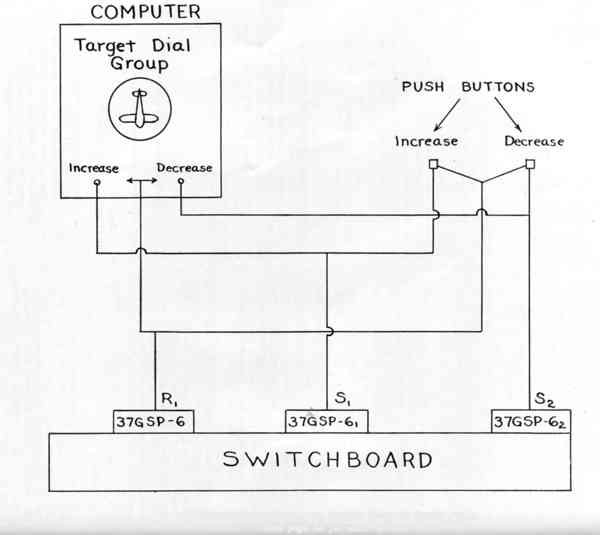
--81-34--
2. Radar picket duty will continue to be hazardous. Better protection of pickets might be gained by the employment of two or more destroyers in close circular formation for mutual support and/or assigning a separate CAP for the sole purpose of defending each ship (or group if more than one) . It is realized that the limited number of ships and aircraft available would make this setup a difficult one to maintain when radar coverage must be furnished on a large periphery.
3. Only destroyers fitted with Mk. 12 and 22 radars should be employed as pickets since this equipment greatly improves the accuracy of antiaircraft gunfire at night.
CO USS Colhoun recommends:
1. It is recommended that no less than 2 DD's be assigned at a time to any radar picket station during daylight.
2. It is further recommended that vessels of other types not be assigned, as DD's must then sacrifice speed, maneuverability and possibly some fire power to help protect them or else leave them with no mutual support, which defeats the original purpose.
3. It is further suggested that each picket vessel be assigned an individual CAP of at least 2 fighters to be controlled by them on a frequency other than primary fighter direction. It is suggested that they orbit ship at about angels 10 or at mattress, whichever is lower, at a range of about five to six miles, that they have strict orders not to chase any enemy beyond ten miles from ship, and that they attack any enemy within 15,000 yards of ship without orders. The ship will have to be thoroughly indoctrinated not to shoot down own planes, but it is thought that this can be accomplished. The presence of friendly planes is a high morale factor to anyone engaged in picket work, because it gets pretty lonesome sometimes.
CO USS Evans comments and recommends:
1. The suggestion of two other commands (USS Newcomb (DD586) and USS M.L. Abele (DD733)) is concurred in, that ships assigned radar picket duty have torpedo mounts removed and replaced by quad. 40MM batteries, thereby reducing the hazard of exploding torpedoes as well as increasing ship's anti-aircraft armament.
THE PRESENT 2200-TON DESTROYERS FITTED FOR RADAR PICKET DUTY HAVE THIS FEATURE.
The assignment of an anti-aircraft cruiser with several destroyers to each of the important radar picket stations is recommended.
CO USS Mannert L. Abele comments and recommends:
1. This ship controlled combat air patrols during 4 days while in the target area prior to Love Day and during 2 nights while retiring with TF 54. No interceptions were attempted during daylight; two were attempted at night, resulting in merged plots but no splashes. The ship was taken under attack on both Radar Picket Stations #4 and #14. In each case the attacks were preceded by reconnaissance planes flying near the ship both the day before and also a few hours before the attacks. It is believed that this action by the Japanese is a definite indication of impending attack and it is strongly recommended that combat air patrols be immediately furnished to ships thus warned.
2. If is further recommended that CAP's be furnished all Radar Picket Stations during all daylight hours.
3. In this officer's opinion there can only be one certain defense against the suicide attack and that is in maintaining a large CAP in the air at all times with each picket having control of at least 8 planes, 4 of which could be directed visually.
4. It is also the opinion of this officer that the small LSM(R)'s are literally worth their weight in gold as support vessels, but larger 40MM batteries should be installed and the number assigned each picket be increased to a minimum of 4. Maneuvering to remain close to supports is difficult but not impossible.
CO USS Pringle comments:
1. It is realized and well understood that the covering of a number of radar picket stations with a special CAP is difficult due to lack of available planes. However, when attacks in force are expected and predicted as this apparently was, it is felt that the number of planes at the availability of and in the immediate vicinity of each radar picket should be at least enough to handle 10 or 12 enemy planes which approach. As
--81-35--
the situation occurred, the CAP assigned Radar Picket #14 was in another area altogether helping others in the same trouble.
In addition it is felt that interceptions should be made further than thirty-five miles for several reasons. One is that it gives the fighters additional time to eliminate attackers, another is that it would break up any concerted attack by a large number of aircraft such as attack the pickets in one group. It goes without saying that one or two destroyers are overwhelmed by 12 to 15 Jap aircraft flying around them Indian fashion.
CO USS Purdy recommends:
1. CAP when provided to Radar Pickets should be divided normally, when conditions permit, into (1) an intercepting CAP under the FDO) and (2) a protective CAP under the Visual FDO). For optimum results the protective CAP should patrol on both sides of a prescribed axis (usually ship's course or general bearing line) .
2. Visual fighter direction is a vital necessity if the protective CAP, now assigned radar picket destroyers, is to be effective to the maximum degree.
CO USS Mullany comments and recommends:
1. It is recommended that when destroyers are used in picket stations they be assigned in pairs for mutual anti-aircraft support. If these were not available at the beginning of the OKINAWA operation, the destroyers damaged in picket stations were subsequently less available. If possible, important picket stations should be occupied by cruisers or larger vessels; antiaircraft cruisers would be especially effective.
2. The decision to give protection to radar pickets in the form of two VF's was noteworthy. These ships are performing the most important function in the protection of the operation. Radar pickets should operate in pairs, as air cover might not always be available. Unfortunately this fact was proved by the sinking of several pickets and the loss of many lives.
3. It is this officer's opinion that the OBB's should be used as radar pickets when their bombardment assignments are completed. Experience has indicated that suicide bombers favor DD's and similar types over the larger, more heavily armored ships. OBB's could be especially fitted out for RP duty and given a small craft A/S and A/A screen. These ships could "absorb" several planes without great loss of life much better than destroyers - as the saying goes, "Don't make a boy do a man's work."
CO USS Murray comments:
It is believed that the action on 27 March 1945 again demonstrates the effectiveness of pickets in giving early warning and in repelling air attacks. At the time of this action there was "some confusion" on the Group Inter-Fighter Direction circuit in regard to the overall picture. Yet, it was quite possible to keep a fairly accurate picture in the relatively small sector covered by the picket station. When the attacks on BRUSH and Murray occurred, both ships were still separated by some 3000 or 4000 yards. Murray had not yet attained position. It is believed that pickets separated by about 1000 yards afford the greatest mutual protection against air attack.
CO USS Sterett recommends:
1. The Commanding Officer recommends that radar pickets be manned by two or three destroyers when in "hot" areas. If destroyers are not available, a cutting down of number of stations and doubling-up might be advisable. While the Commanding Officer does not wish to detract from the splendid performance of the LCS's, he does not believe they can adequately support a radar picket. Their speed and the short range of their batteries result in the destroyer leaving them far behind. The only alternative is to stay with them at slow speed and hope to knock the planes down. The two LCS's were placed in column 500 yards astern of Sterett, for concentration of fire. However, as the raid closed and was finally sighted, the LCS's were about 3000 yards astern, within effective range of only one (the first) of the planes attacking the Sterett. However, their complete attention was taken up by the fifth plane which hit the mast of LCS-36. They do furnish some armed support and a lot of moral support, so nave a definite value if larger ships cannot be obtained.
2. It is also recommended that every other picket station be designated a fighter director ship with at least one division of CAP. Where radar picket stations are so widely separated, one ship cannot always intercept all the raids, especially where land is between the stations.
ComDesDiv 126 recommends:
1. Combat Air Patrol: - This is the greatest protector of the Radar Picket. They don't stop
--81-36--
all the suicides, but they whittle the numbers down to the point where a ship gets an even break with her guns.
2. V.T. Ammunition: - For suicide runs coming directly in at the ship, 100% V.T. fuzes is believed to give the most efficient form of defensive fire. On many of these runs, the attack develops so suddenly that there is no time for a solution or even a range, and the time fuze is worthless or at best, if a close barrage is used, only partially effective.
3. These above two recommendations have already been taken care of by CTF51 to the limit of available resources. A two-plane CAP for the sole use of the picket has been directed; and the allowance of V.T. ammunition has been increased from 610 to 750 rounds per Radar Picket Destroyer.
4. Supporting Ships:
Another Destroyer: - This is a must if the Radar Picket is to stand any chance of continual survival. The Japs can't and don't always overlook the distinct advantages of a simultaneous attack from opposite sides. It is almost bound to succeed unless there are two destroyers in mutual support.
LCS and LSM Types: - Until the attack on 12 April, the writer felt that the LCS's assigned to him were wonderful moral support, especially handy to pick up the pieces after that one suicider got through. But as far as additional AA support was concerned, it was felt they were almost more trouble than they were worth. They got lost at night, wouldn't always stay where they were put and were too slow to keep within mutually supporting distance of the destroyers. After the way they took care of a group of VALs on the 12th, the writer would particularly desire to have them in any kind of engagement.
SMALL SUPPORTING CRAFT HAVE ACCOUNTED FOR NUMEROUS ENEMY PLANE KILLS. THEIR WORK HAS BEEN OUTSTANDING. INDOCTRINATION OF THIS TYPE VESSEL FOR MUTUAL SUPPORT IS RECOMMENDED.
RELIEVING RADAR PICKETS ON STATION
CO USS Colhoun comments and recommends:
From dawn of Love day until Love plus five, except for one night retirement and fueling, Colhoun was assigned to radar picket duty, most of the time controlling a CAP. Except when raids occurred or no CAP was present in the area, CIC personnel both of ship and CASCU fighter director team stood watch and watch. This was necessitated by number of circuits to be manned, manning visual fighter director station, and necessity for being able to control a CAP at anytime. It is believed that a similar condition obtains in all fighter director DD's. It is recommended, therefore, that if possible, fighter director DD's be relieved on station at least every 48 hours.
ComDesDiv 126 comments:
Radar Picket duty is very trying on ships. They fully realize that ceaseless vigilance is their only salvation and that to relax for an instant and give the suicide attacker the advantage of surprise is suicide for them. The Battery, Engineering Plant and Combat have to be ready to function at 100% efficiency, immediately, 24 hours a day. Four days, it is believed, is about the maximum length of time a ship can maintain the peak alertness required for picket duty in this area.
RESCUE OF PERSONNEL FROM CRASHED PLANES
ComDesRon 48 comments and recommends:
1. In the rescue of personnel from crashed planes or damaged ships it is frequently necessary for a swimmer to go after the person in the water. These swimmers usually have a light line tied to them and controlled from the ship. In several instances it was noted that this line became so heavy in the water that it not only impeded the swimmer but in one case nearly drowned him. It is believed that a light line buoyed at intervals of 15 or 20 feet by a small kapok or cork ball would overcome this difficulty. The swimmer should further be provided with a light canvas harness to which his line is attached. The best swimmer on the ship should be detailed to this duty and trained for it while the ship is in the rear areas. When the ship is proceeding to the rescue these men should strip, put on their harness and be ready to go when the ship approaches the man in the water. Such preparations will pay big dividends in the rapidity with which personnel
--81-37--
are rescued. It is fine and heroic for the nearest bystander to jump overboard and try to rescue a man in danger of drowning, but the chances of completing the rescue are much greater if a trained swimmer with proper equipment is ready.
2. It is therefore recommended that ships take every opportunity to train at least 4 expert swimmers for rescue work and to properly equip then with harness and buoyed life lines. In this connection it is noted that the experiments by Commander Destroyers, Atlantic Fleet in using an empty depth charge attached to a long buoyed line and fired from "K" guns offer great possibilities for use by destroyers.
SMALL CRAFT
CO USS Hugh V. Hadley comments:
The LSM 193 and the LCS 83 were responsible for recovering all personnel in the water. These two ships did a remarkable job in caring for the wounded, expediting the fighting of the fire, and later towing.
SMOKE, USE OF
CO USS Purdy comments:
This vessel used smoke only as ordered when at anchor in HAGUSHI BEACH area or at KERAMA RETTO. When in the HAGUSHI BEACH area, smoke coverage was excellent. In the KERAMA RETTO area the Purdy was stationed to windward where smoke coverage was relatively ineffective. It is believed that too few smoke boats are stationed to adequately cover ships in that direction.
ComPhibPac comments:
The determining factor of whether or not to use smoke as a protective measure against suicide attacks, as well as against orthodox enemy air attacks, is whether or not the concealment of ships from enemy planes is sufficient to warrant the reduced efficiency of our AA fire. If ships are only partially covered with smoke or if only some of the ships are covered, the use of smoke is not warranted. The following principles are based on the above:
Do not use smoke at sea, day or night.
Use smoke to cover an anchorage or transport area during low visibility, morning or evening twilight, should be governed by whether or not the ships can be effectively hidden from view of enemy planes. If planes can see the ships or make out their outlines through the smoke, smoke should not be used.
The decision to use smoke to cover an anchorage or transport area during low visibility, morning or evening twilight, should be governed by whether or not the ships can be effectively hidden from view of enemy planes. If planes can see the ships or make out their outlines through the smoke, smoke should not be used.
SUICIDE ATTACKS, COUNTERMEASURES FOR
TRAINING
CO USS Metcalf comments and recommends:
1. It is my opinion that present day anti-aircraft practices are inadequate to properly prepare a ship's gunnery organization in fighting off suicide attacks. Inasmuch as suicide attacks are predominant at the present time, immediate consideration should be given toward providing appropriate drills and practices.
THE ABILITY TO HIT FAST-MOVING PLANES WITH MACHINE GUNS AND AUTOMATIC WEAPONS IS ACQUIRED ONLY THROUGH CONSTANT PRACTICE AND IS AN ART WHICH MUST BE EITHER CONTINUALLY PRACTICED OR RAPIDLY LOST.
2. In this connection, it is recommended that something resembling the following exercise be regularly scheduled for individual ships. Assign a small group of planes (2-5) , preferably fighters or other high speed types, to simulate single and multiple suicide attacks and to approach the ships as closely as safety will permit. This should be a non-firing exercise in order not to hamper the planes in their approaches and dives. Ship personnel would thus be provided with a close approximation of the suicide attacks; gunnery and control crews could be indoctrinated in correct procedure for sector coverage, shifting targets, and splitting control on multiple attacks.
CONTROL OF AA FIRE MUST BE DECENTRALIZED. EACH MACHINE GUN MOUNT CAPTAIN, DIRECTOR, AND SECTOR CONTROL OFFICER MUST HAVE THE AUTHORITY TO OPEN FIRE WHEN CIRCUMSTANCES REQUIRE, WITHOUT VIOLATING SAFETY PRECAUTIONS.
--81-38--
3. Indoctrination of all key personnel according to a carefully pre-arranged procedure must be the cardinal rule. During an actual attack there is not time enough for detailed oral instructions and orders. Delay or misunderstanding is fatal.
4. ComCarDiv 22 recently provided his task unit with the best anti-aircraft practice in which I had ever participated. Five planes were employed, each towing a sleeve. These five planes then proceeded to make runs on the formation at their own discretion. I utilized this excellent opportunity to simulate actual combat conditions -mostly by turning over all gunnery control to the gunnery officer, and he in turn to his various control assistants. While I kibitzed at times, fire was commenced and ceased independent of commanding officer; solely according to what targets were in range, and whether or not other ships and friendly planes were clear. Other ships did the same, and all maneuvered independently to unmask their own batteries and to avoid adjacent ships. It was a most valuable practice. While it involved a little more risk than the usual type of practice, it provided something that approached the "real thing". The various control officers and gun crews were immensely pleased with the initiative, added responsibility, and ever-changing situation thus presented to them. Obviously, such a practice should not be attempted by any ship that has not had a considerable amount of previous firing of a more fundamental nature. But as an advanced practice it was the best I have ever seen.
5. The lookout organization must be positive and effective. Training and emphasis must be exacting and continuous. Sector discipline is vitally important.
A LARGE NUMBER OF SUICIDE ATTACKS HAVE BEEN SUCCESSFUL BECAUSE THEY WERE SURPRISES. IT IS UNFORTUNATE THAT THE EXPERIENCE OF OTHERS IS SOMETIMES NOT SUFFICIENT TO PRESS HOME THE VITAL NECESSITY FOR KEEN, ALERT VISUAL LOOKOUTS. RADAR IS EXCELLENT BUT IT HAS BLIND SPOTS.
The general quarters lookouts should be the same men regularly detailed - and the very best men fitted for that job. Recognition training goes hand in hand. It is a tremendous relief during air action to know that no bogey is going to slip in undetected, and neither the Captain nor the gunnery officer can see them all. Lookouts must wear telephones at all times, and their reports must get through direct to Bridge, CIC, Control and Air Defense.
6. Additional and well-trained automatic control officers should be stationed on after stack Mk.51 directors and after Mk.51 director, ready to exercise sector control on their own initiative.
7. Minimize, by doctrine and previous arrangements, all communications and verbal orders and instructions while in action.
FIRING
CO USS Metcalf recommends:
1. Commence firing main battery at maximum range possible.
AND KEEP FIRING.
Even if no hits are made, it will frequently drive them off. At the same time, however, it may cause them to turn on weaker ships in the vicinity.
2. Initially, it is better to open fire with Mk. 37 director control. If taken under multiple attack, there is no alternative but to split the battery. This takes lots of practice, for the shift must be done at a critical time when targets are closing fast.
SHIFT OF CONTROL MUST BE WELL PLANNED IN ADVANCE AND THOROUGHLY PRACTICED. IF SURPRISE OR MULTIPLE ATTACKS ARE EXPECTED, CONTROL OF 5" SHOULD BE GIVEN TO THE MACHINE GUN DIRECTORS. IF LONG-RANGE COLLECTIVE FIRE IS DESIRED OH A SINGLE TARGET, IT IS THEN A RELATIVELY SIMPLE MATTER TO SHIFT BACK.
3. I am inclined to think that for a plane diving straight in at close range, local control at the mount is as good, or perhaps better, than Mk. 51 control. About the only chance then is to score a direct hit, and if the plane happens to be flying "straight down the sight" that chance may be good.
4. Don't underestimate the 20MM guns. At close range they can pour it out fast and will hit more often than the 40MM. while they certainly won't disintegrate a plane, they may knock it out of control or throw pilot's aim off.
USE ALL AVAILABLE GUNS THAT CAN BEAR AND RANGE. IF FIRING OUT OF OWN SECTOR, MAINTAIN SECTOR LOOKOUT, REGARDLESS. THIS REQUIRES TRAINING AND PROPER DOCTRINE. RATES OF FIRE VARY WIDELY BETWEEN SHIPS.
--81-39--
MAKE SURE THAT YOU ARE OBTAINING THE MAXIMUM EFFICIENCY THAT YOUR GUNS ARE CAPABLE OF PERFORMING. WATCH THE CONDITION OF YOUR READY AMMUNITION, YOUR AMMUNITION SUPPLY, CASE DISPOSAL, AND THE ADJUSTMENT OF YOUR RECOIL SYSTEM.
CO USS Evans comments:
1. Each air attack presents its own peculiar problems. In this one there were a total of about 50 planes attacking Hadleyand Evans over a period of an hour and a half. It was our good fortune that during most of the action the planes came in singly or in a group from one bearing at a time. We were thus enabled to concentrate guns on one attack, shoot it down, and shift immediately to the next attack. In the final stages when planes were diving from three directions simultaneously, one out of the sun, we could only continue to shoot and maneuver at maximum speed and hope for the best.
2. Hadley and Evans attempted to remain in close support of each other, and succeeded several times in rendering mutual assistance. The frequency and varied direction of attacks was such that some separation was inevitable as we maneuvered at high speed and turned radically to bring all guns to bear.
3. It is felt that the following points should be stressed in this type of action:
Lookouts: Use all available bridge and control personnel and insist on a strict sector watch, especially when a plane is being flamed elsewhere.
SG Radar: Invaluable for early warning on low-flying bogies.
When under observation, change course frequently ten, twenty or thirty degrees.
When attack begins, or before if possible, increase speed to maximum.
Maneuver to bring maximum number of guns to bear on each attack. Then, when possible, change direction of turn at the last moment.
Use rapid continuous fire, with ammunition ratio four VT to one AA Common.
THE EXPERTS RECOMMEND 100% VT FUSED PROJECTILES.
Although against doctrine, it was found necessary in many cases to shift fire from one target flamed to the next attack, keeping guns in full automatic and continuing to shoot while slewing director.
Use of Mark 53 ammunition: Excellent performance in every way, especially in that no prematures were observed on very low flying bogies.
Use of push buttons and synchro motor on computer for rapidly changing target angle. This is described on page 34.
THIS COMPUTER WILL BE UNDER CONSIDERATION BY THE BUREAU OF ORDNANCE.
TACTICS, ENEMY
CO USS Colhoun comments:
1. The state of training of enemy pilots encountered was evidently primary. They could dive, keep their nose on the ship and hit her, but nothing else. They started strafing at extreme ranges and wasted considerable ammunition thereby. They made dive bombing runs from almost abeam, even after ship was dead in the water, and could not score hits. The whole attack was evidently directed by some one plane, possibly one of the Vals to make the last bomb run.
2. Considerable time elapsed after we arrived on the scene before decision to attack was reached. The Vals' disposition was changed to a very loose echelon prior to attack. Apparently planes were designated to either bomb or suicide. The ones who strafed, bombed but did not suicide Colhoun, although two did attempt to suicide Bush, one of which was successful. The tactics by planes of original formation never varied throughout attack. They were all easy targets, but a vital point must be hit beyond 1000 yards range if attack is to be repelled. Otherwise, in a dive attack such as here, momentum carries plane on into ship at some point.
CO USS Hugh W. Hadley comments:
The enemy planes employed no special tactics except during the final attack to completely surround the ship and dive simultaneously.
CO USS Murray comments:
1. The Japanese pilot who attacked the Murray left little doubt as to his determination and
--81-40--
ability. He made a beautiful run. At the onset of the action there was a feeling of confidence that should the concentrated fire of the AA battery fail to shoot him down, either a torpedo or a suicide dive could be avoided. It was considered the best tactics would be to keep all guns firing as long as possible and then maneuver to have the plane pass as far ahead as possible. These tactics, accompanied by considerable good luck, assisted in avoiding more serious damage.
2. In retrospect it appears that the Jap pilot made three mistakes during his approach:
He failed to strafe the exposed bridge personnel and #1 40MM gun which was obtaining several hits.
His torpedo release was slightly late.
There was a split second after he released his torpedo in which he still could have crashed into the forecastle in the vicinity of gun #2. He apparently made no attempt to do so.
ComDesDiv 106 comments:
No standard pattern is apparent. Sometimes suicides seem smart and employ decoys just outside effective gun range, while another tries to sneak in unobserved on the other flank; or simultaneous attacks from opposite sides are made. At other times they seem to have no plan of attack, are just down on a one-way trip and what they flatten themselves against doesn't appear to make much difference to them. An example of this is the crashing into the little LCS gunboats. Approaches vary all the way from steep dives to low over the water skimmers, with the largest percent of hits coming from low glides where the pilot can make minor adjustments up to the last minute. Some observers of suicide tactics claim that by opening fire early you draw the suicides in on yourself. From the writer's experience he is of the opinion that if you shoot early and accurately enough you will drive him off to somebody else.
CO USS Aaron Ward comments:
1. The entire enemy attack appeared to be exceptionally well co-ordinated by a pilot, or pilots, who understood the limitations of a destroyer's fire power and took every advantage of smoke and the crippled condition of the ship. In fact, it appeared that the attacks were directed from a control plane which never took part in the assault.
RECENT INFORMATION CONFIRMS THE FACT THAT THE LEADER USUALLY IS EQUIPPED WITH RADAR AND BRINGS HIS GROUP WITHIN VISUAL RANGE. IT IS QUITE POSSIBLE THAT THE MORE EXPERIENCED LEADER COULD ALSO DIRECT AND COORDINATE THE ATTACK. CAP OR SHIP GET THAT LEADER!
The operation was too well co-ordinated and executed to have been the individual inspiration of each pilot. Not only did planes come in from different directions at the same time, but on several occasions the first plane was followed immediately by another approximately 1,000 yards astern of the first. This type of attack was seen to deal the death blow to the U.S.S. Little.
2.It is not understood why the Kamikaze does not strafe the target on the way in, as it appears to be a simple matter to close and lock the firing key to the machine guns. Casualties would have been greater had this been done in the attacks on the Aaron Ward.
3. All planes are believed to have used the bridge and main battery director as a point of aim, but due to the radical maneuvering of the ship and the heavy volume of fire forward, this target was never reached; all planes crashed into the superstructure amidships.
4. Before making his run, each pilot circled the ship at a distance of 5 to 6 miles, apparently seeking the most advantageous position from which to start his dive.
THE CAP HAS DONE A MAGNIFICENT JOB IN THESE OPERATIONS BUT OFTEN TOO FEW PLANES HAVE BEEN AVAILABLE. THE CAP MUST BE LARGE ENOUGH AND CAREFULLY STACKED TO TAKE CARE OF A SITUATION OF THIS TYPE, WHICH OBVIOUSLY WAS NOT THE CASE AT THIS CRITICAL MOMENT.
In each suicide run, planes appeared to take their lead angles at a range of from three to four thousand yards, increasing speed considerably and steadying on the attack course. No attempts at evasion were made on any of the runs after the pilot had finally committed himself.
--81-41--
5. From the results of the bombing, it can be readily determined that the pilots had very little experience in bombing and that the release of bombs may have been accidental, caused by the shock of hits from gunfire of this ship.
TACTICS, OWN
CO USS Purdy comments and recommends:
1. The tentative doctrine for maneuvers of vessels under attack by suicide planes is, in general, to present a broad target angle (maximum fire power to bear) . Other circumstances permitting and when excessive spray on board will not result, it is strongly suggested that the ship's heading be selected to give a maximum (high) speed of relative wind in order (1) to reduce smoke interference and (2) to present a more difficult target problem to the enemy. In other words, if a choice of up-wind or down-wind offers itself in order to bring maximum battery to bear, a course up-wind is considered preferable.
2. The knotty problem of whether to maneuver to avoid a suicide attack or a bombing (torpedo) attack is believed answered by considering all attacks to be of the suicide type (most dangerous) .
THE FOLLOWING IS RECOMMENDED:
- IN GENERAL CONSIDER ALL PLANES SUICIDE.
- GO TO MAXIMUM SPEED AND STAY THERE.
- MANEUVER:
- KEEP GOOD RELATIVE WIND.
- GET PLANES ON BEAM.
- HOLD STEADY IF IN LOW APPROACH.
- MANEUVER ON A HIGH APPROACH (ABOVE 30°) .
CO USS Stanly comments and recommends:
1. Ship handling while under attack by Japanese suicide "buzz bombs" affords the conning officer an occupation but, due to the comparative speeds involved, fails to produce the desired result, i.e. a complete miss or a near miss by the attacking plane. Only major structural damage to the plane will stop or deflect it from its course. Once it is inside the range of automatic weapons it is almost too late. From there on in pilot error is the only escape.
2. It is recommended that the Combat Air Patrol while attacking these planes concentrate on killing the pilot rather than setting the plane on fire.
CO USS Sterett recommends:
The Commanding Officer does not claim he knows the answer to Japanese suicide planes. He believes the best method is to increase speed as much as possible when planes are in sight, keeping the planes broad on the beam and to turn hard right or hard left when the plane is in its dive. The turn away is recommended most strongly as most destroyers have greater machine gun power aft than forward. In making a turn after the dive has commenced, there is usually no loss of gun power as the plane has either crashed the ship or been splashed by the time the ship can turn 60°
CO USS Taussig comments:
And finally a grateful acknowledgment is given the double rudders peculiar to the destroyers of the 2200-ton class. In past months they have demanded and received much care and attention but during the high speed evasive maneuvers against one dive bomber and two suiciders they repaid their debt. They, along with a deadly gunnery and CIC performance, saved the Taussig to fight another day.
WEATHER
CO USS Hugh W. Hadley comments:
Wind and sea calm, visibility to north and east unlimited, visibility to west cloudy and a mist haze. During the attack the force maneuvered to the east and south to get out of the misty haze in order to see the enemy planes more clearly. The haze to the west would not have prevented the enemy plane from seeing us.
--81-42--
[END]



